PDA IB Lecture 9, 10, 11, 12: Dose-Response Curves: Agonists and Antagonists
1/154
There's no tags or description
Looks like no tags are added yet.
Name | Mastery | Learn | Test | Matching | Spaced |
|---|
No study sessions yet.
155 Terms
Ligand/Drug Classification (3)
1. Agonist (full & partial)
2. Antagonist (competitive & allosteric)
3. Inverse agonist
Exogenous agonist
initiates a response when it binds to receptor (activates the receptor)
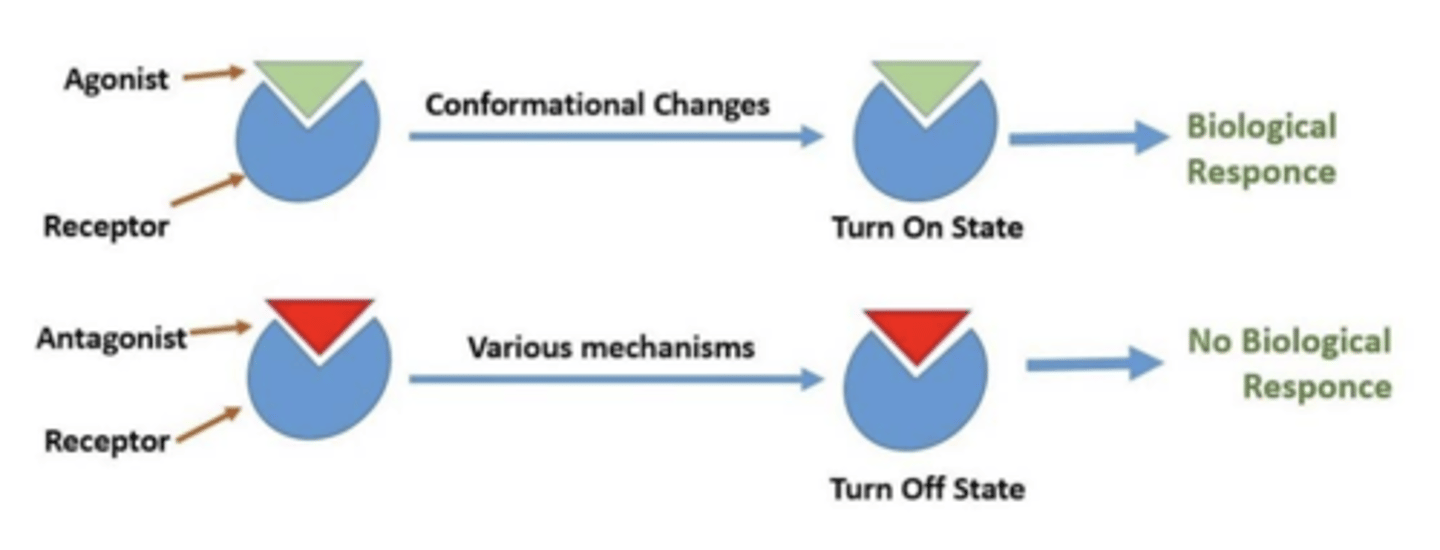
Endogenous agonists
binds to receptors and mimics the effects of the endogenous compound
(neurotransmitters, hormones, etc.)
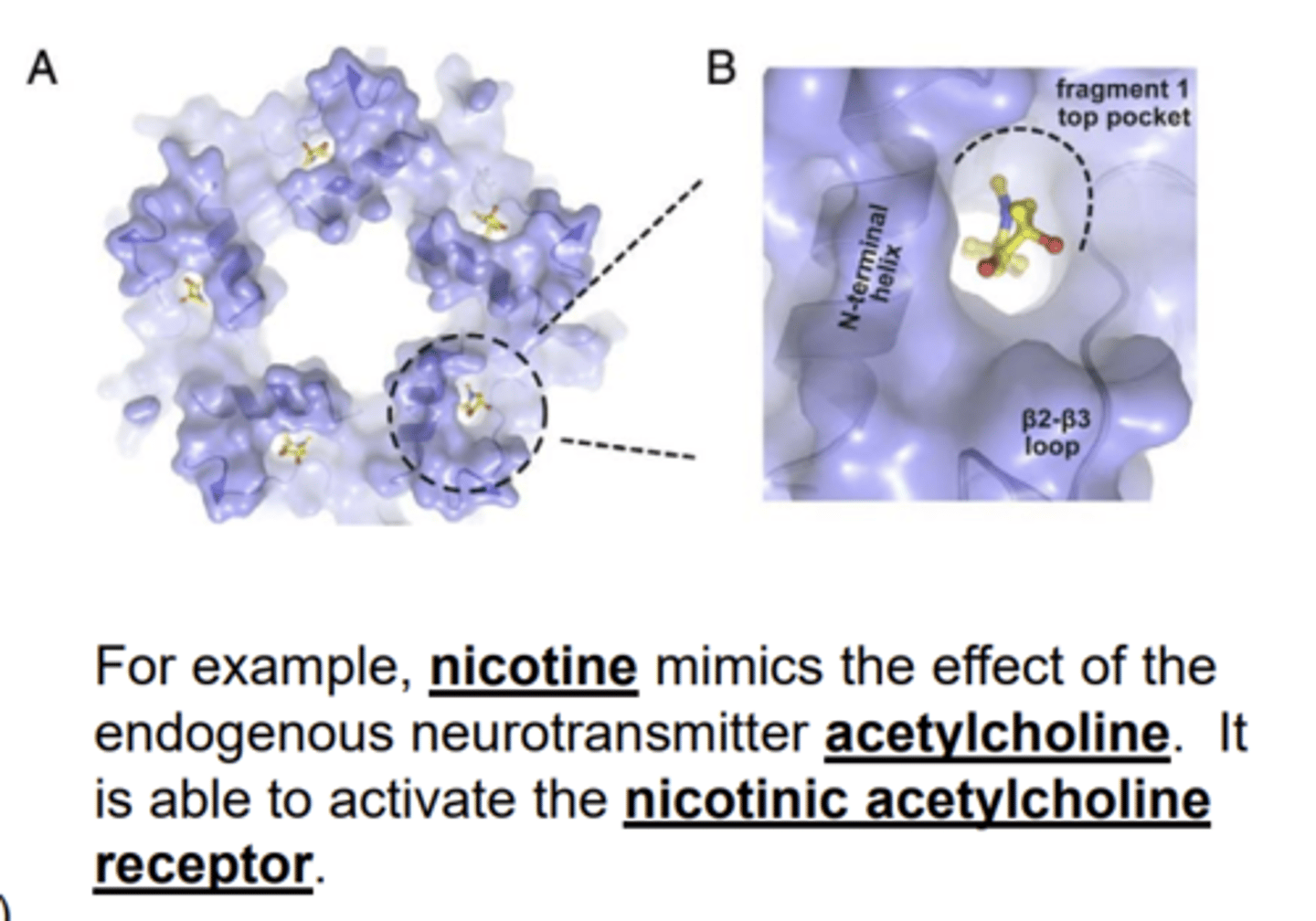
Antagonist
drug that interferes with or inhibits action by binding/blocking a receptor rather than activating it.
T/F: Antagonist activity may be reversible or irreversible depending on the longevity of the antagonist–receptor complex, which depends on the nature of antagonist–receptor binding
TRUE
- Agonists bind to a receptor and ______________
- Antagonists bind to a receptor but ______________________________
- activate it
- would not activate it

Affinity******
the ability of an agonist/antagonist to bind to a receptor
- how well a drug and receptor recognize each other
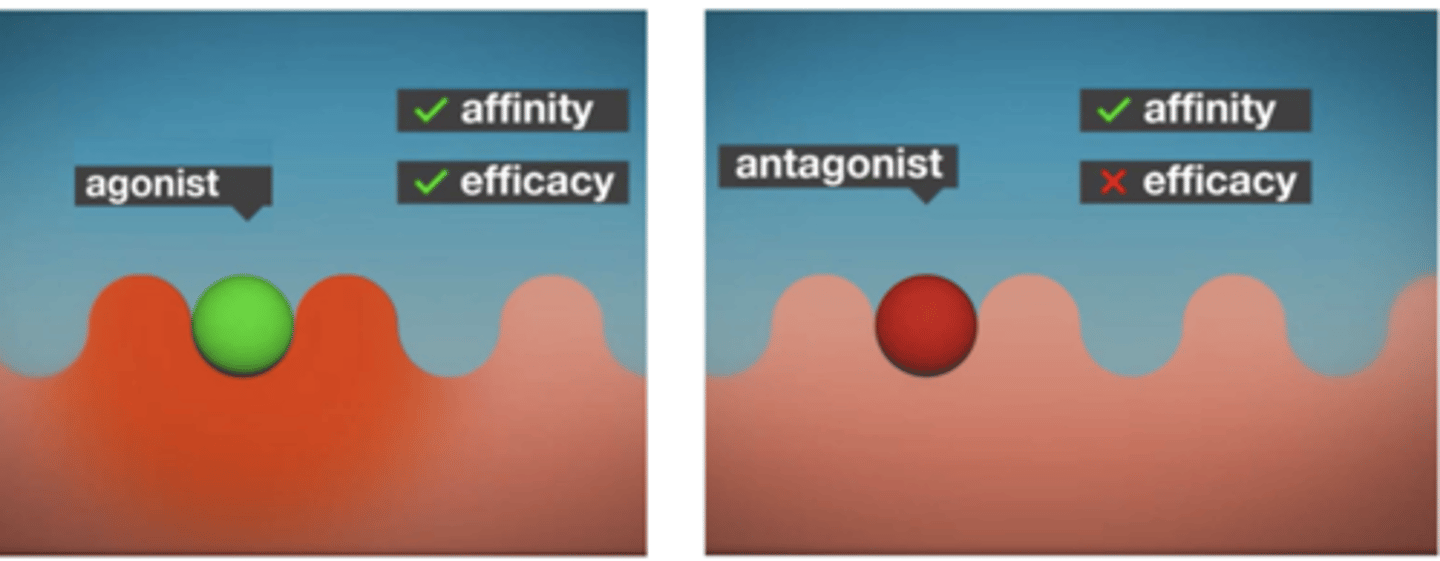
Efficacy ******
the ability of an agonist to activate a receptor
- maximal effect an agonist can achieve at the highest practical concentration
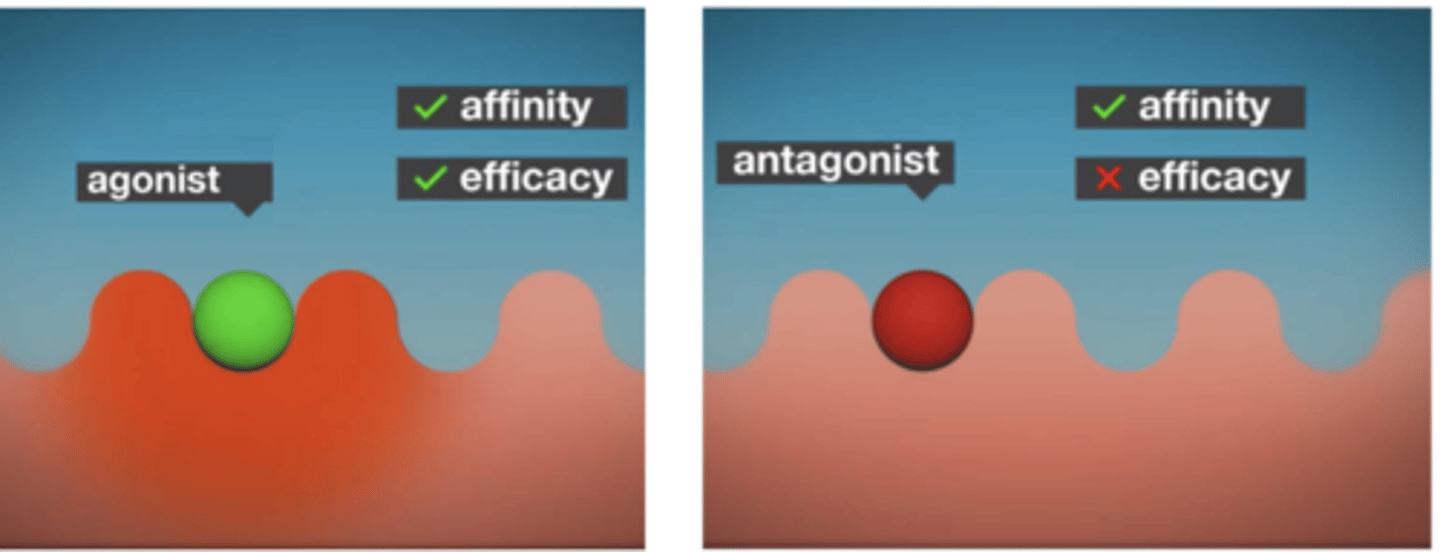
[D/L] =
[R] =
[DR/LR] =
[D/L] = drug/ligand
[R] = receptor
[DR/LR] = drug-receptor complex
Is the binding of a functional group to a receptor a reversible reaction?
YES
Ligand/drug affinity equation
What is K+1?
What is K-1?
K+1 = Association rate
K-1 = Dissociation rate
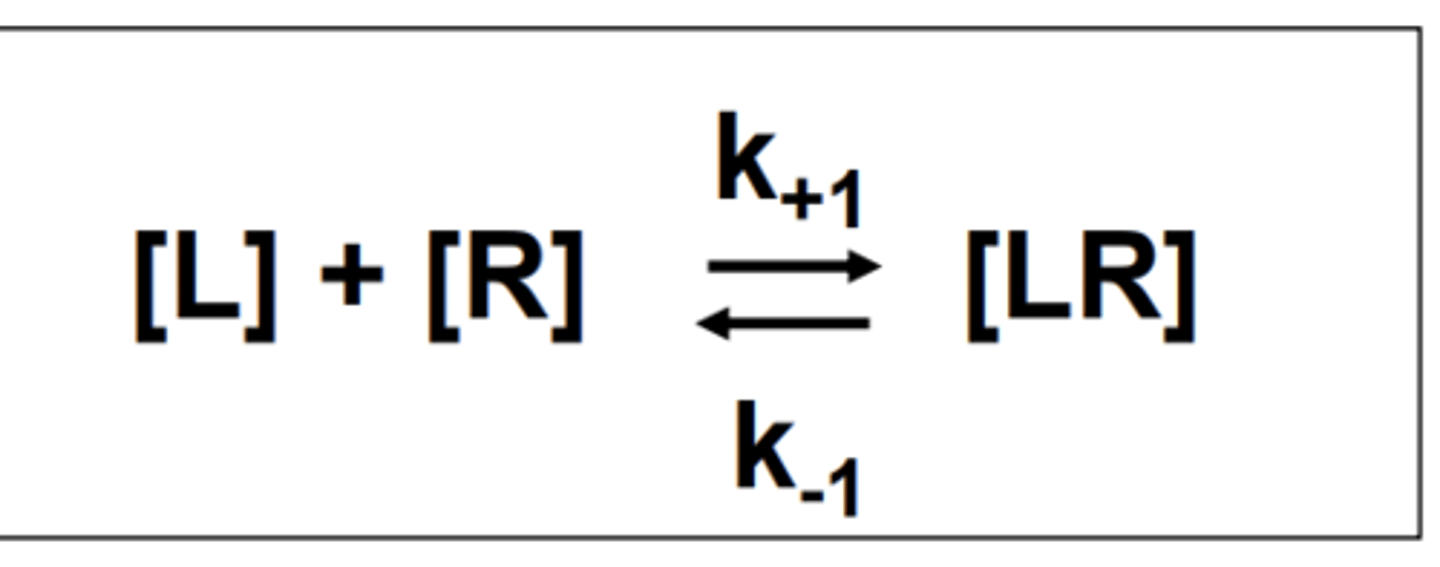
What is the reversible formation of the ligand-receptor complex LR governed by?
the chemical property of affinity
High-affinity ligand binding results from....
greater attractive forces between the ligand and its receptor
Low-affinity ligand binding involves less...
less attractive forces
Pharmacophore
structural feature (or chemistry) of the drug that interacts with the ligand binding pocket of a specific receptor

k+1[L][R] = k-1[LR]
What is (k+1[L][R])?
What is (k-1[LR])?
(k+1[L][R]) = formation of ligand-receptor complex [LR]
(k-1[LR]) = dissociation of LR into L and R
at equilibrium the formation of the ligand-receptor complex is equal to the dissociation of LR into L and R
![<p>(k+1[L][R]) = formation of ligand-receptor complex [LR]</p><p>(k-1[LR]) = dissociation of LR into L and R</p><p>at equilibrium the formation of the ligand-receptor complex is equal to the dissociation of LR into L and R</p>](https://knowt-user-attachments.s3.amazonaws.com/7176cfce-ada6-4379-8048-4a41593a6260.png)
Equilibrium dissociation constant KD
At equilibrium, KD corresponds to the ligand concentration [L] at which half of the receptor are occupied
KD = [L]
![<p>At equilibrium, KD corresponds to the ligand concentration [L] at which half of the receptor are occupied</p><p>KD = [L]</p>](https://knowt-user-attachments.s3.amazonaws.com/3800b1ec-fc12-4a31-b3ef-839750533eff.png)
The affinity constant/equilibrium association constant KA
reciprocal of the equilibrium dissociation constant
(likelihood of drug to associate with receptor)
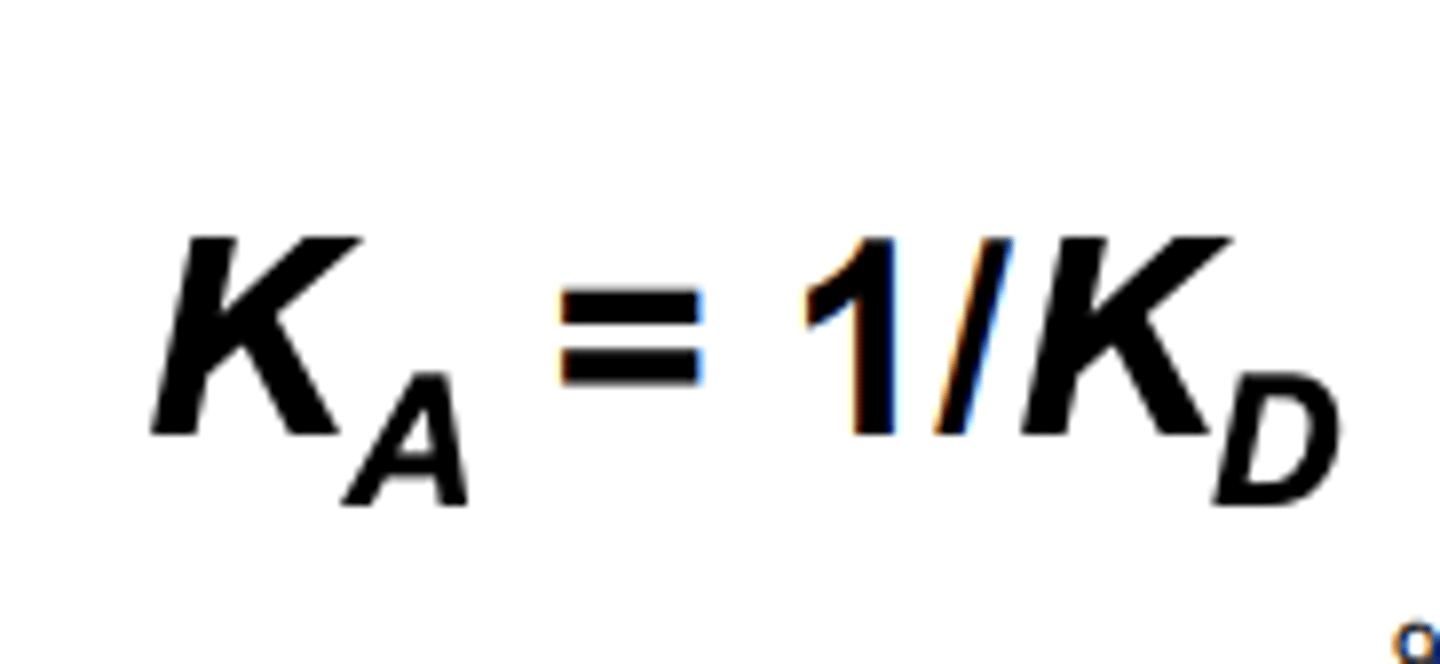
KD units****
concentration units
Ex: 1 M, 1 mM, 1 mcM, etc.

KA units***
1/concentration units
Ex: M-1, mM-1, etc.

Lower KD (or higher KA values) has...
(in relation to affinity and ability to dissociate)
- higher affinity
- difficult to dissociate (hours), nM to pM
Higher KD (or lower KA values) has...
(in relation to affinity and ability to dissociate)
- lower affinity
- dissociates quickly (seconds), mM
How to find KD and KA from hyperbolic curve graph
- On Y-axis, go to 50% and find where it interjects on the X axis
- to find Ka, divide 1 by that number
ex: if at 50%, KD is 20 nM, then Ka is 0.05 nM^-1 (1/20)

Ligand-binding hyperbolic curve graph
RT= Total receptor
RL = Receptor binding ligand complex
Kd = Dissociation constant

Receptor-ligand sigmoidal curve graph
In log, you need to reverse log. LogKd is NOT actual Kd. (have to reverse log)
- B = receptor sites bound drugs
- Bmax = total concentration of receptor sites
- KD = dissociation constant
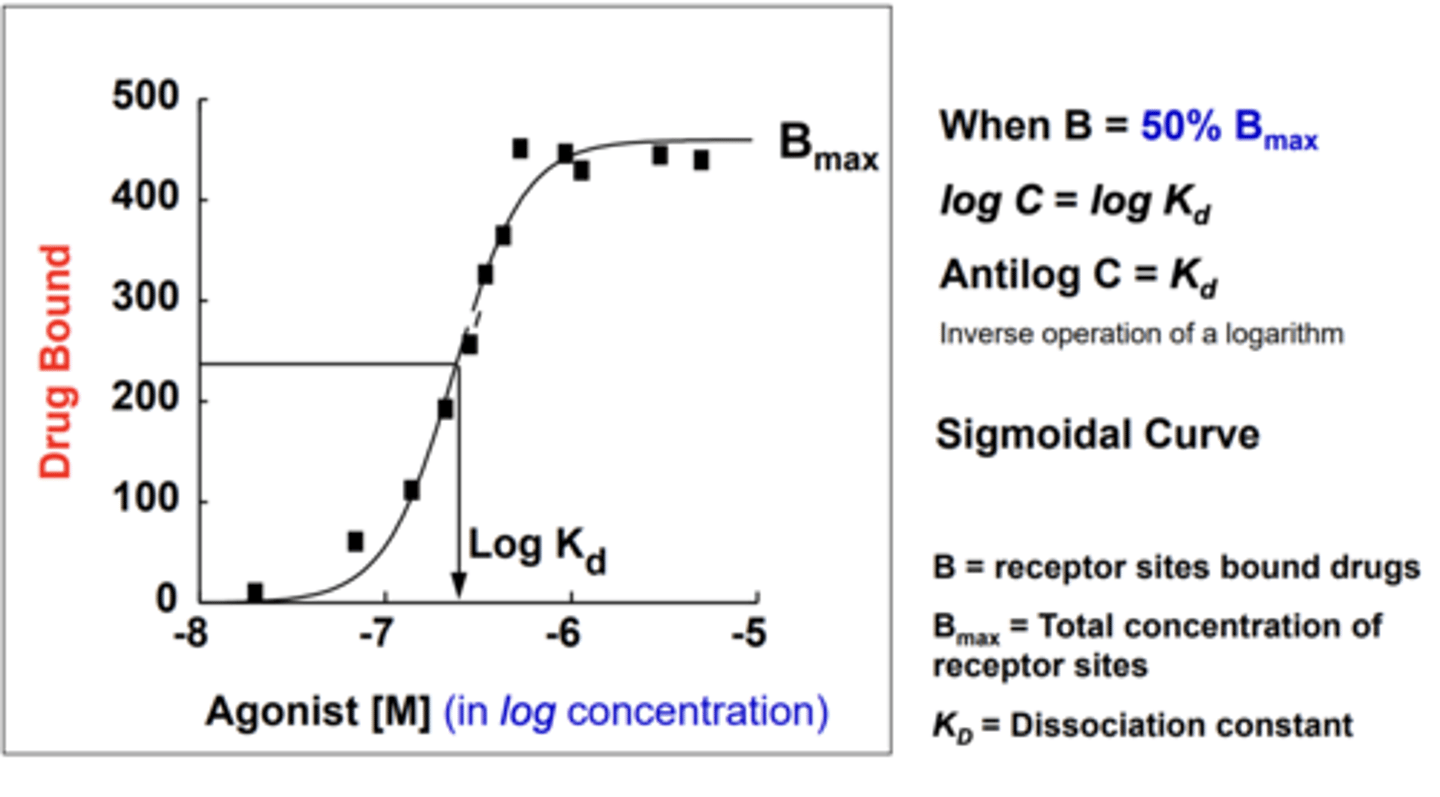
What is the drug-receptor interaction characterized by? (2)
(1) binding of drug to receptor
(2) generation of a response in a biological system
What is a crucial factor in determining drug efficacy?
the reversible formation of the ligand-activated receptor complex (LR*)
Efficacy refers to the highest...
the level of response achievable by a drug
Ligand/Drug Affinity and Efficacy Equation
K+2 = activation rate
K-2 = deactivation rate

EC50
effective concentration of agonist for 50% of the maximal response

IC50
antagonist concentration of an inhibitor that produces 50% of binding inhibition
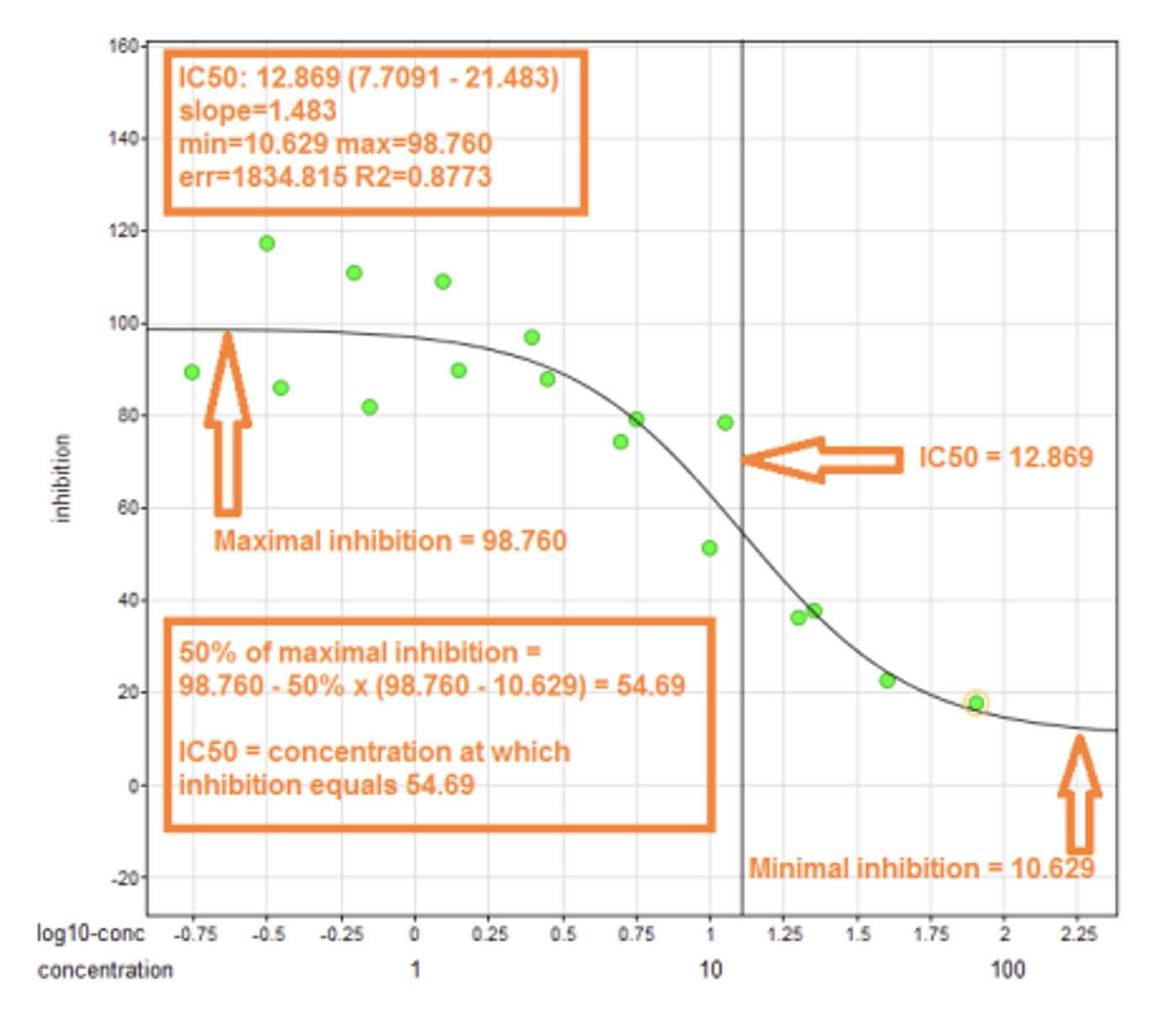
Potency
the amount of agonist needed to elicit a desired response
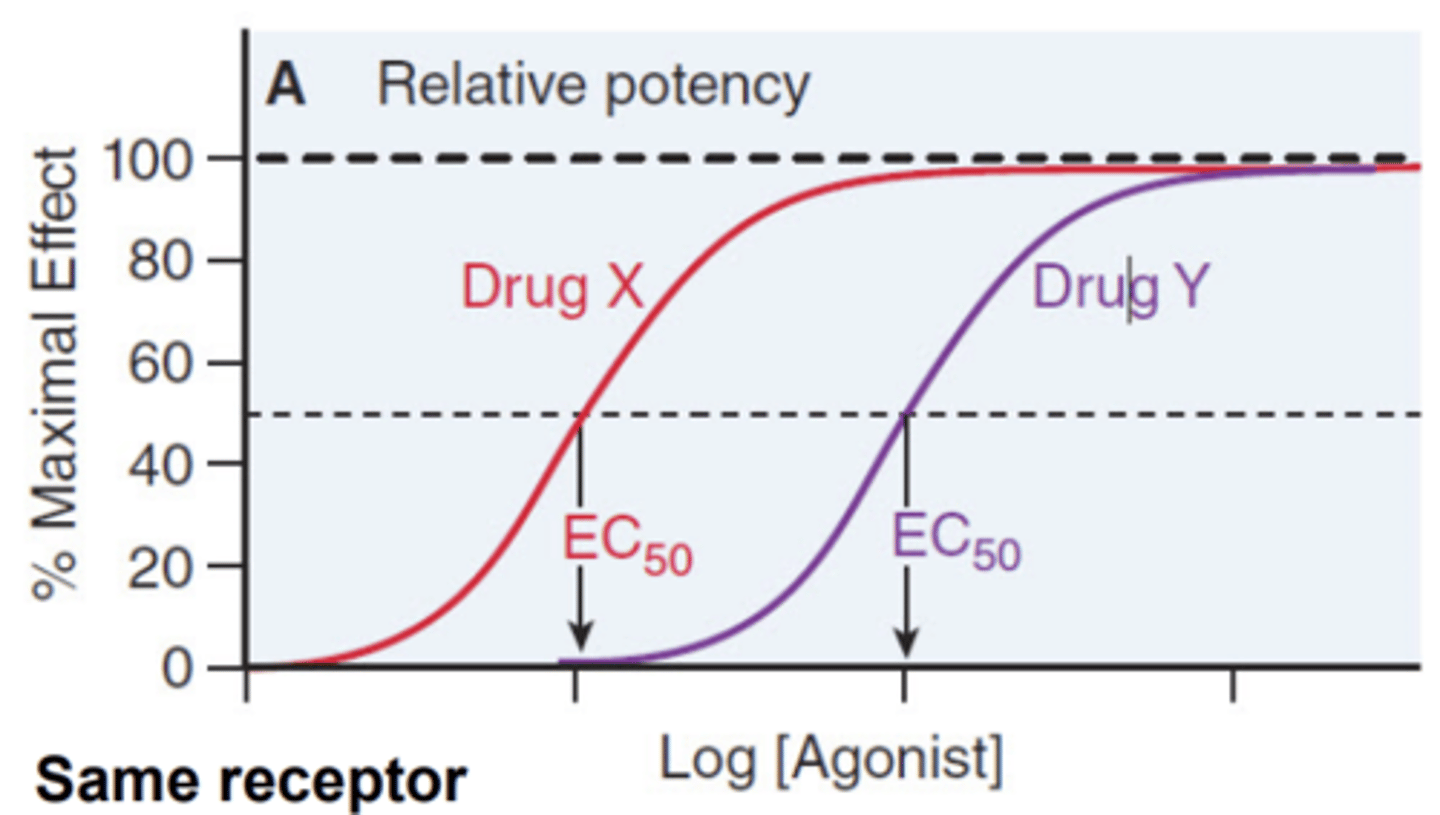
T/F: Potency of an agonist is inversely related to its EC50 value
TRUE
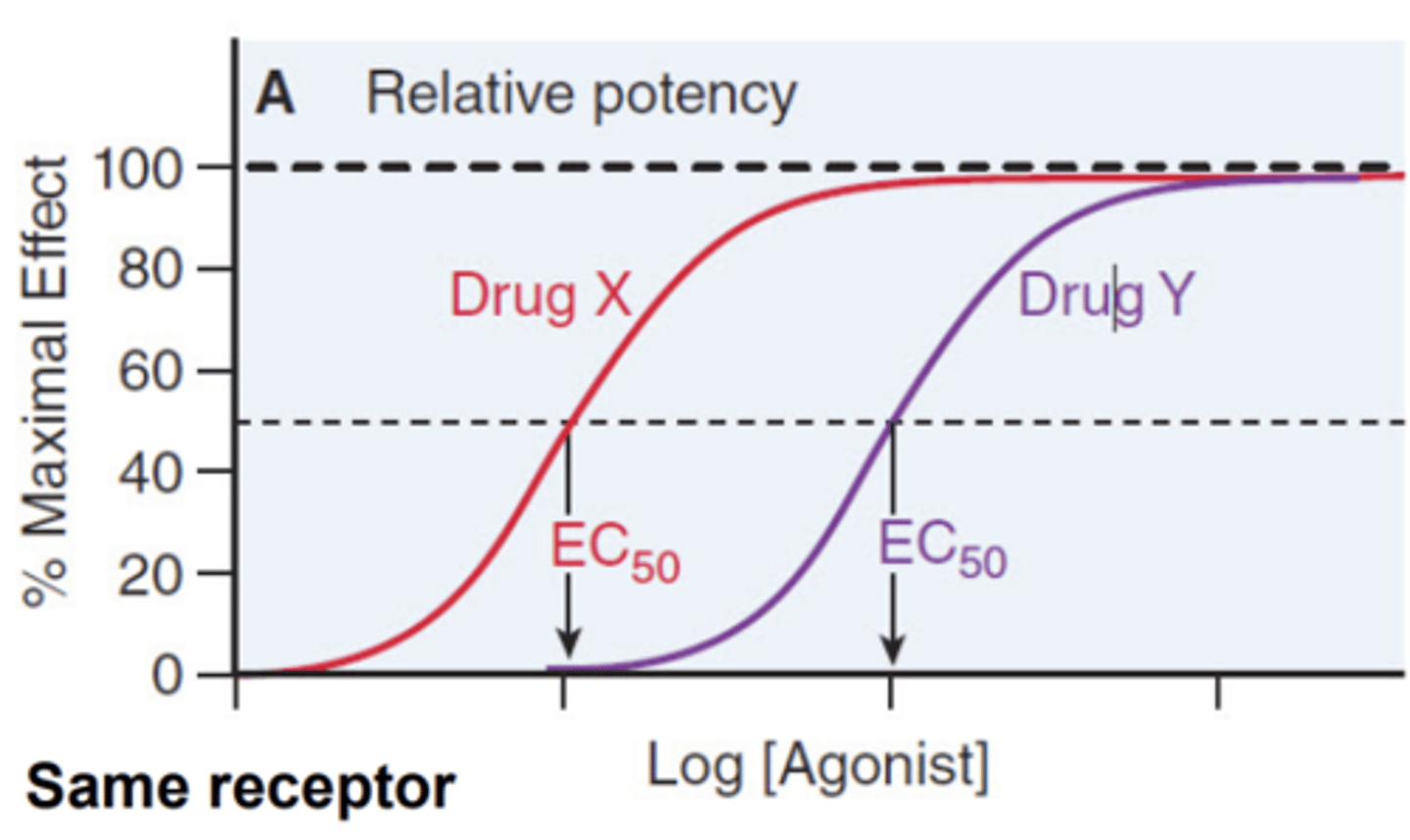
According to the graph, is Drug X or Drug Y more potent?
Drug X is more potent
- its EC50 occurs with less amount of drug
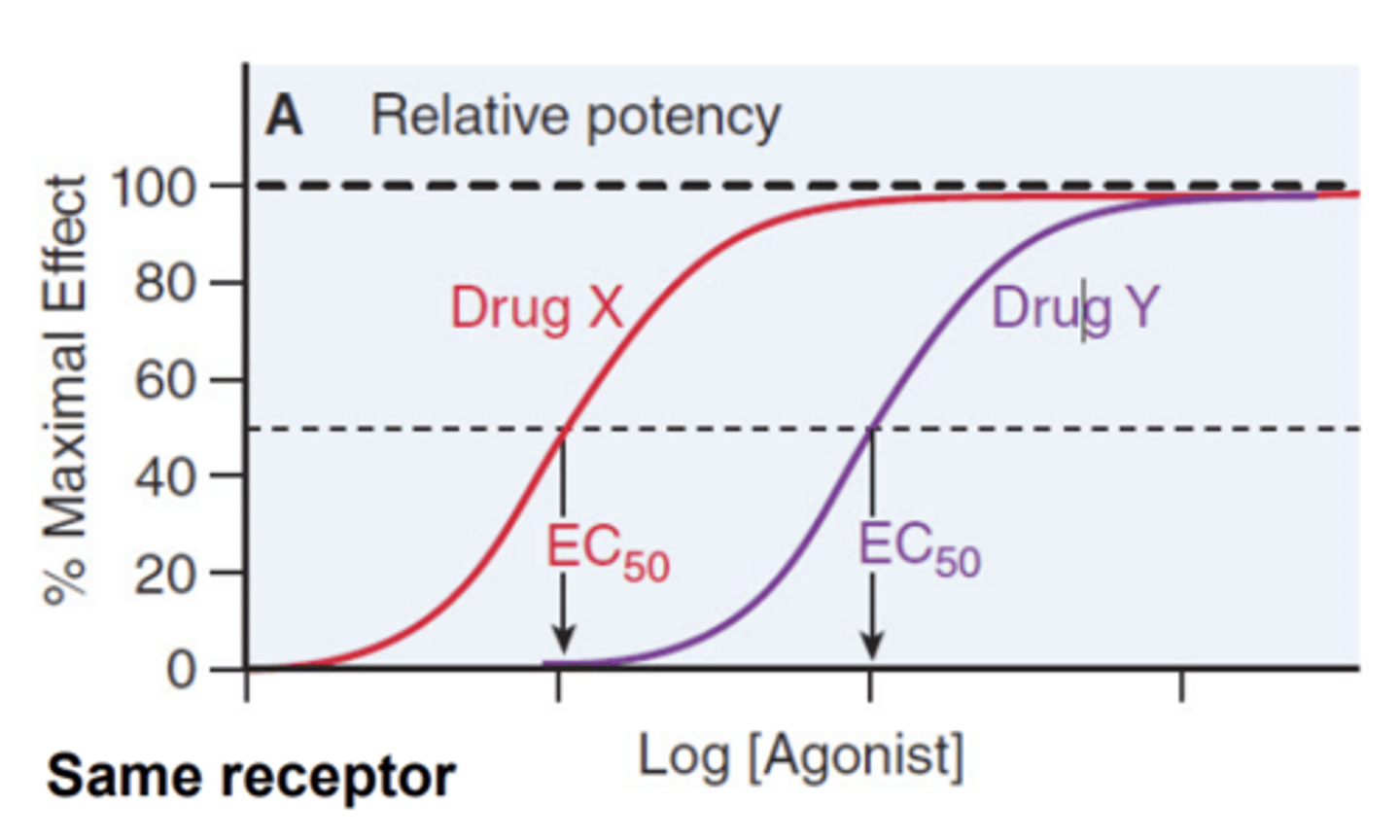
Efficacy is a measure of how well a drug produces a ________________ shown by _____________ reached by the curve
- response
- maximal height
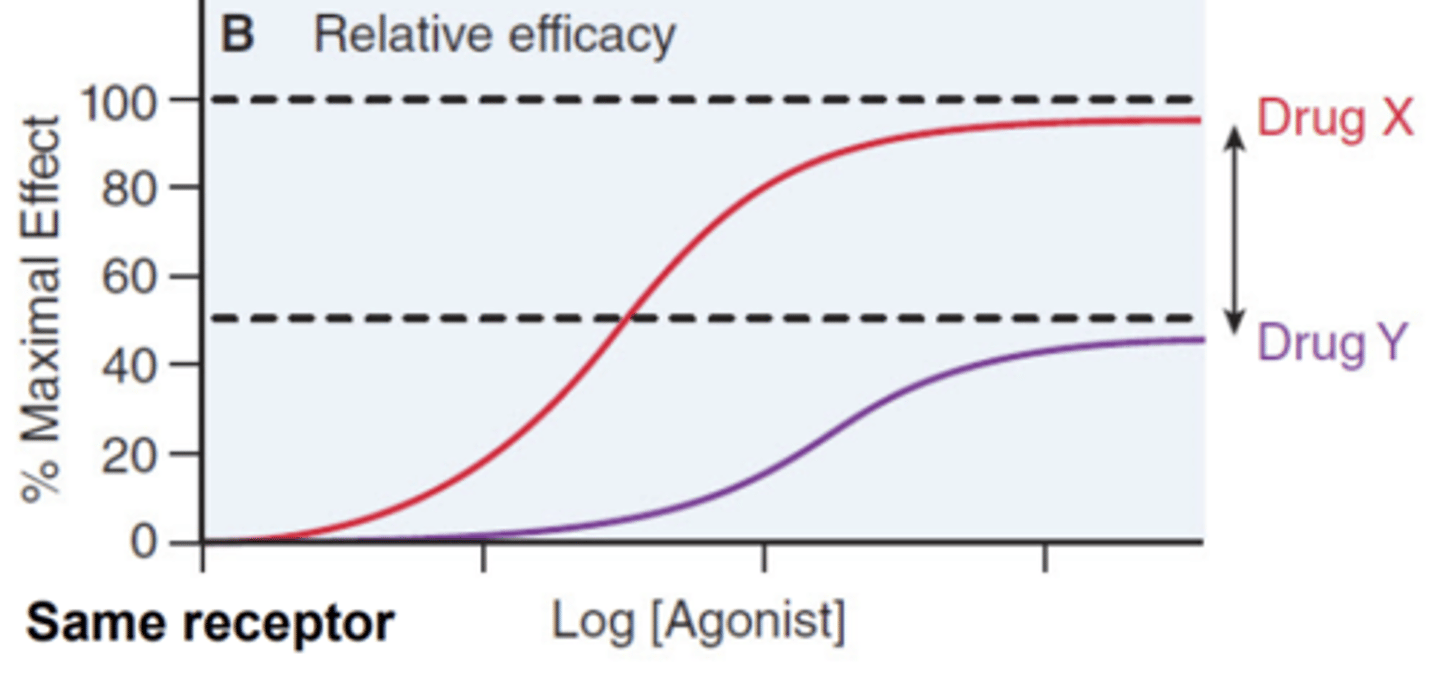
According to the graph, which has higher efficacy; Drug X or Drug Y?
in terms of efficacy, they are equivalent
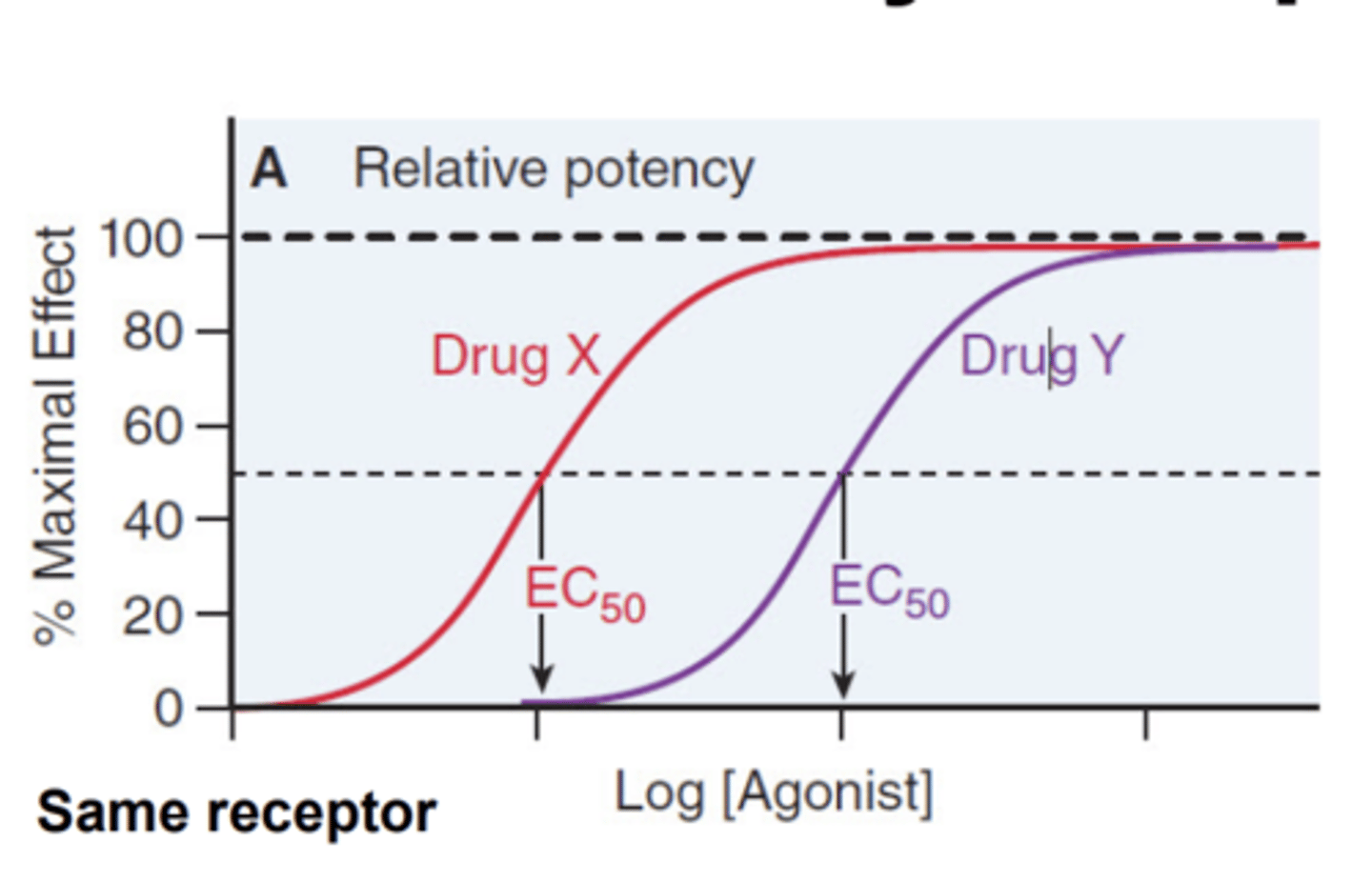
Does Drug X or Drug Y have higher relative efficacy?
Drug X is more effective than drug Y
- drug X is more potent than Y

Full agonists
elicit a maximal response
- can induce a conformational change leading to maximal effect
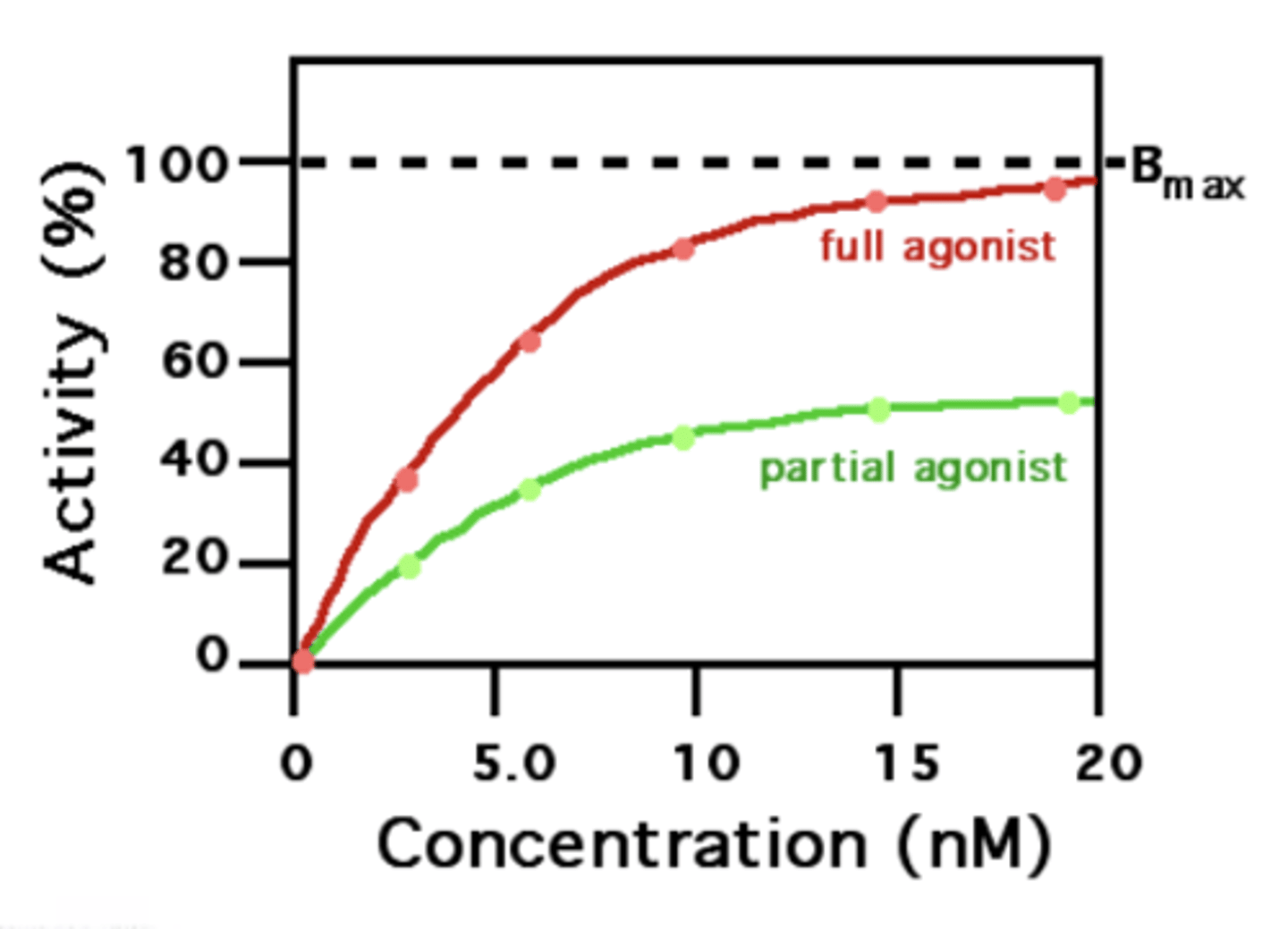
Partial agonist
can activate receptor, but are unable to elicit a maximal response
- can induce some degree of receptor activation but not of sufficiently

Full agonist high vs. low binding affinity:
Which is more potent? Which has higher efficacy?
- Drug X is more potent
- Drug X and drug Y have the same efficacy (both can induce maximal response)

...
...
The maximum response that can be produced by the partial agonist is _________ than _____________ of the max response of the system
less than 100%
T/F: The maximal response of a partial agonist is higher than that of a full agonist
FALSE
the max response of a full agonist is higher
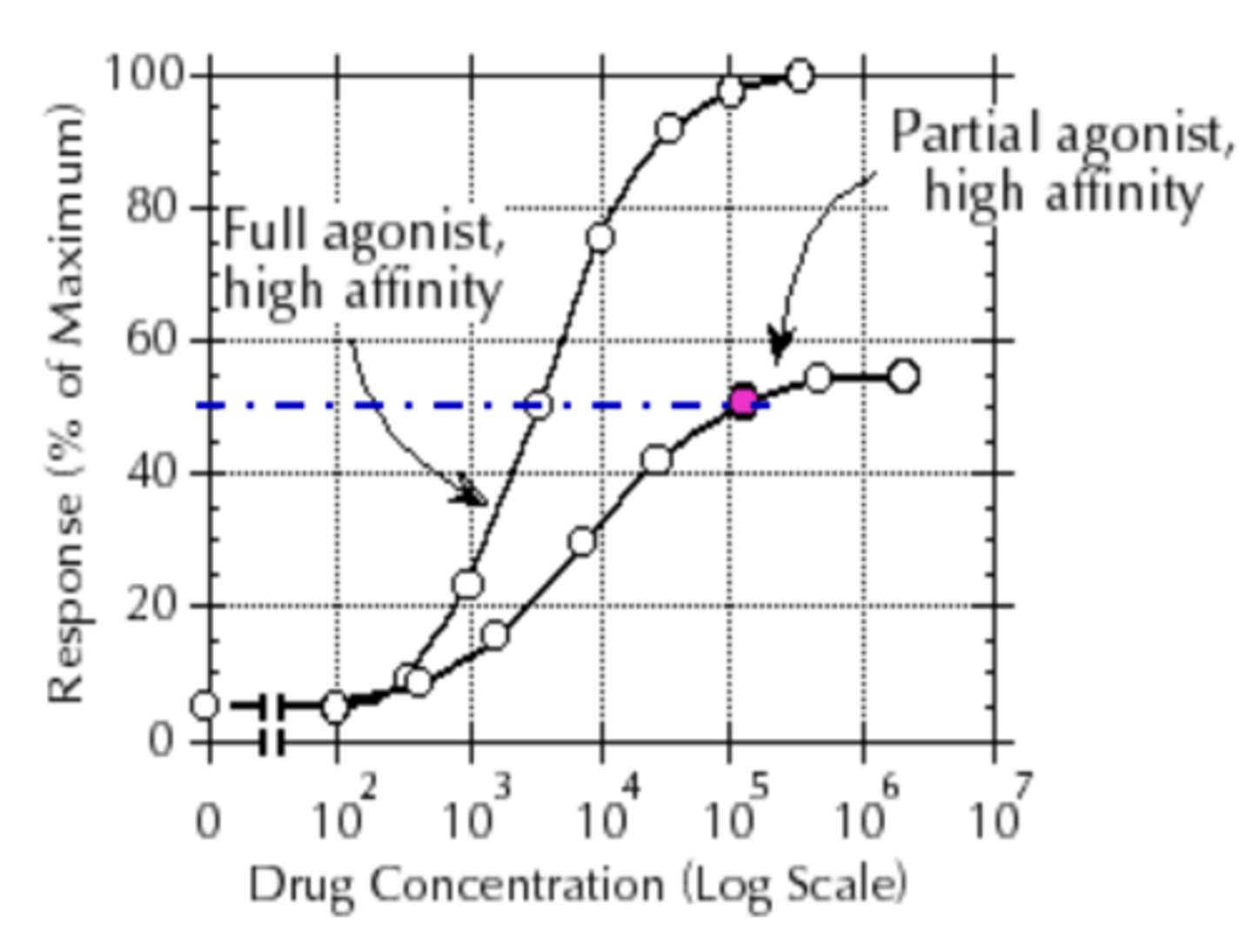
Do full agonists or partial agonists have a greater efficacy?
full agonists
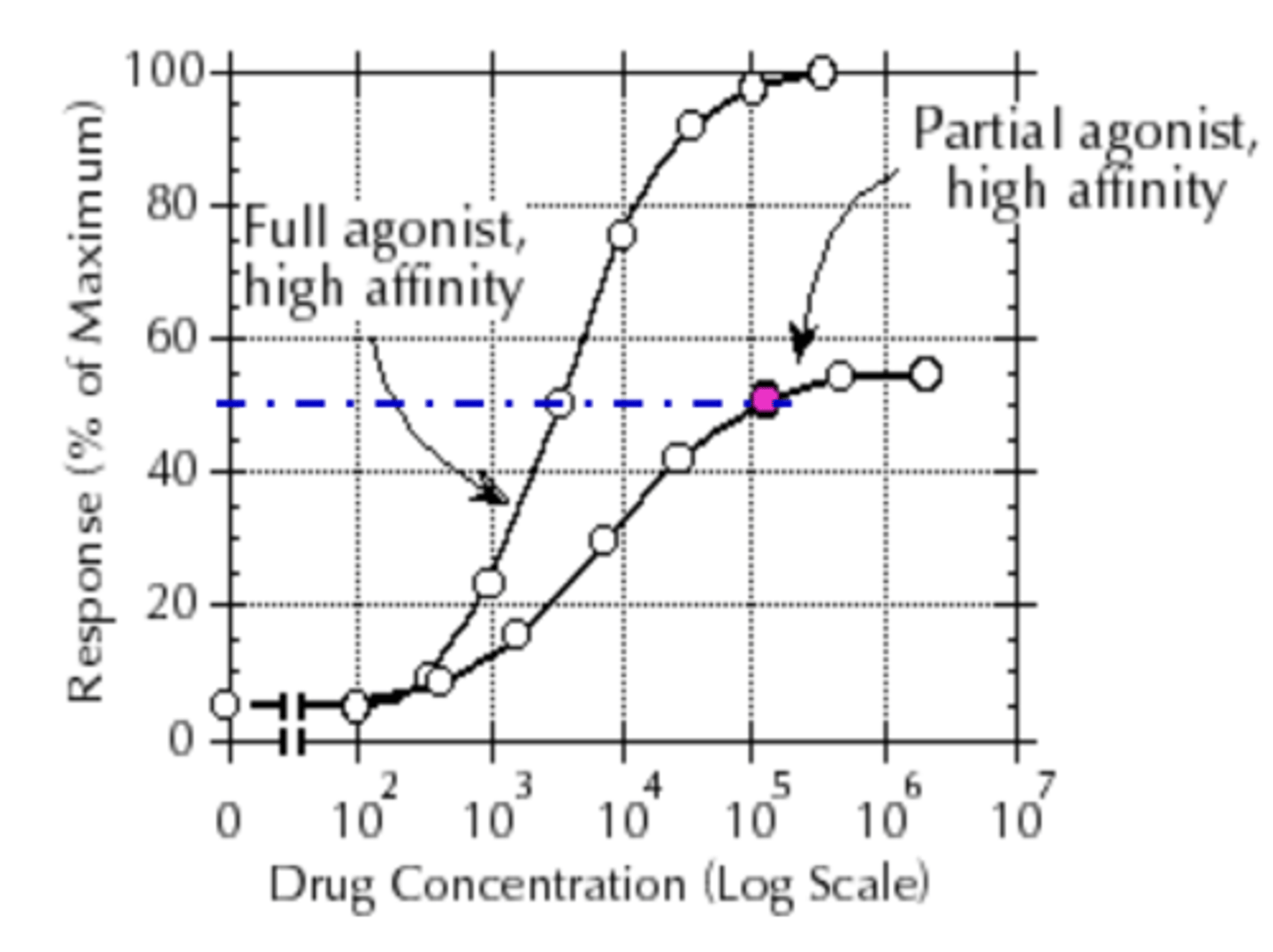
What happens if a partial agonist drug and a full agonist drug are used at the same time?
the partial agonist will act as an antagonist, competing with the full antagonist for binding sites
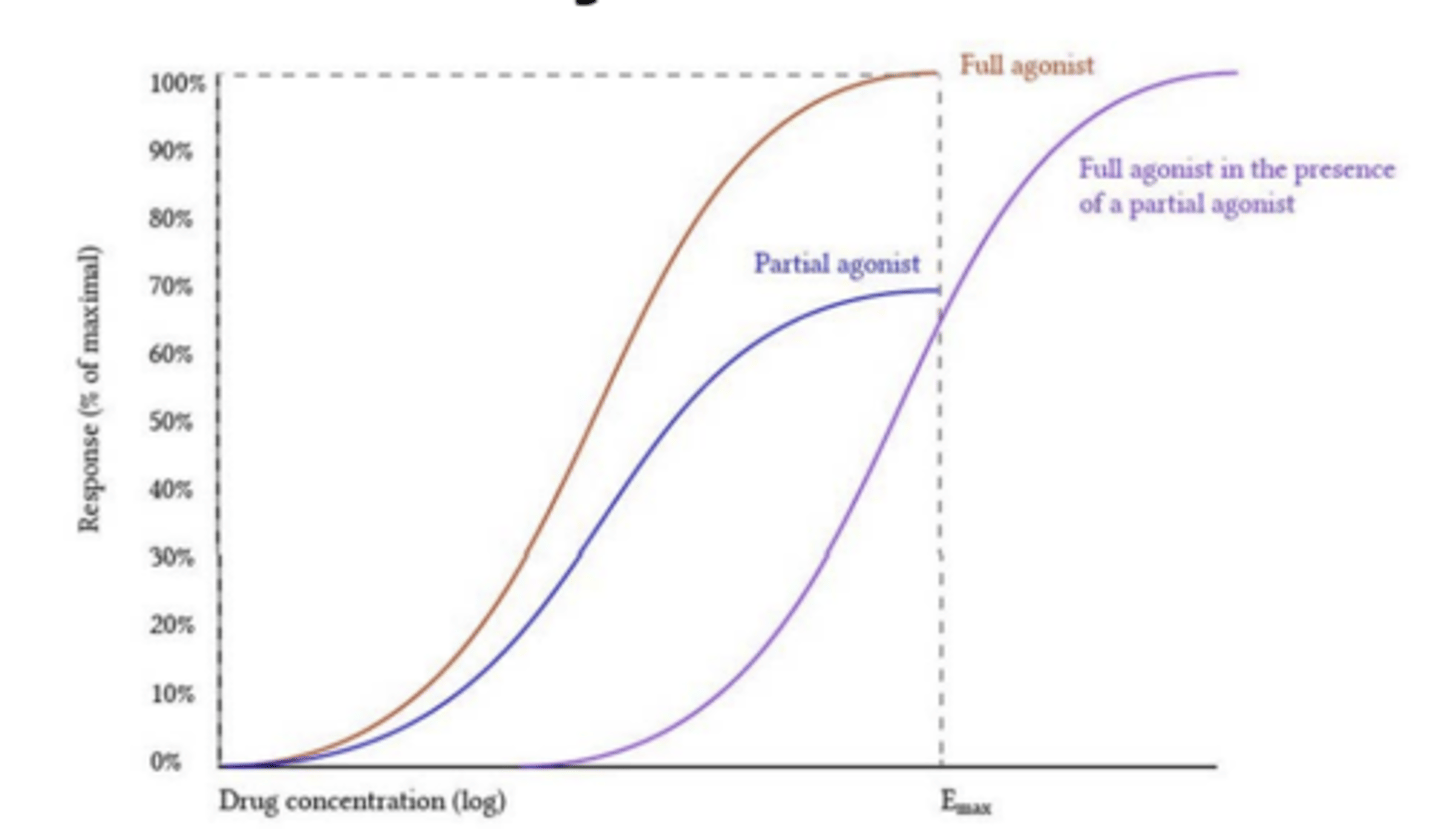
of the binding sites occupied by the partial agonist, some will not be ______________ which reduces the ____________________
- activated
- total drug effect
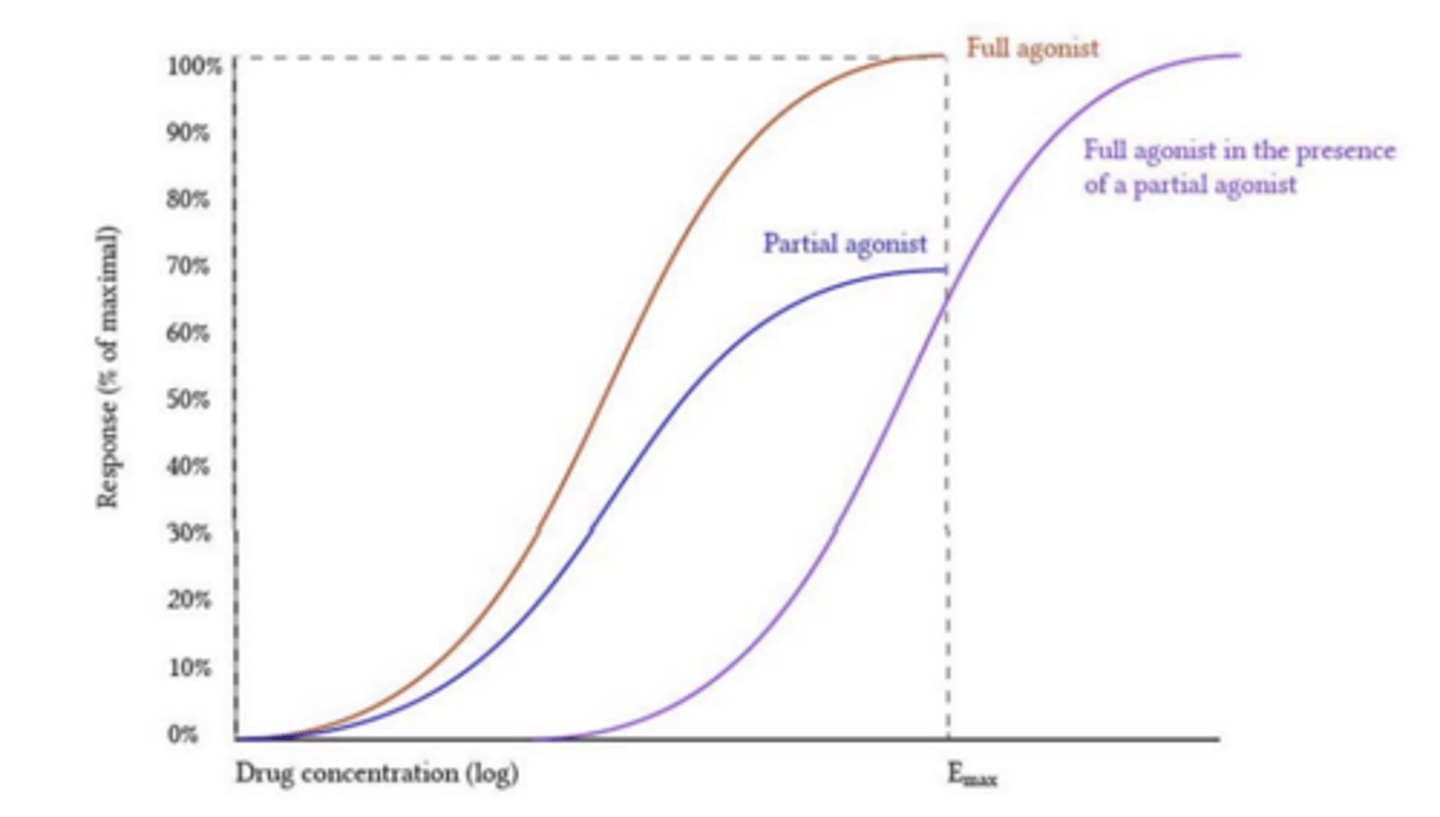
T/F: In the presence of both a full agonist and a partial agonist, a maximal response can still be achieved
TRUE
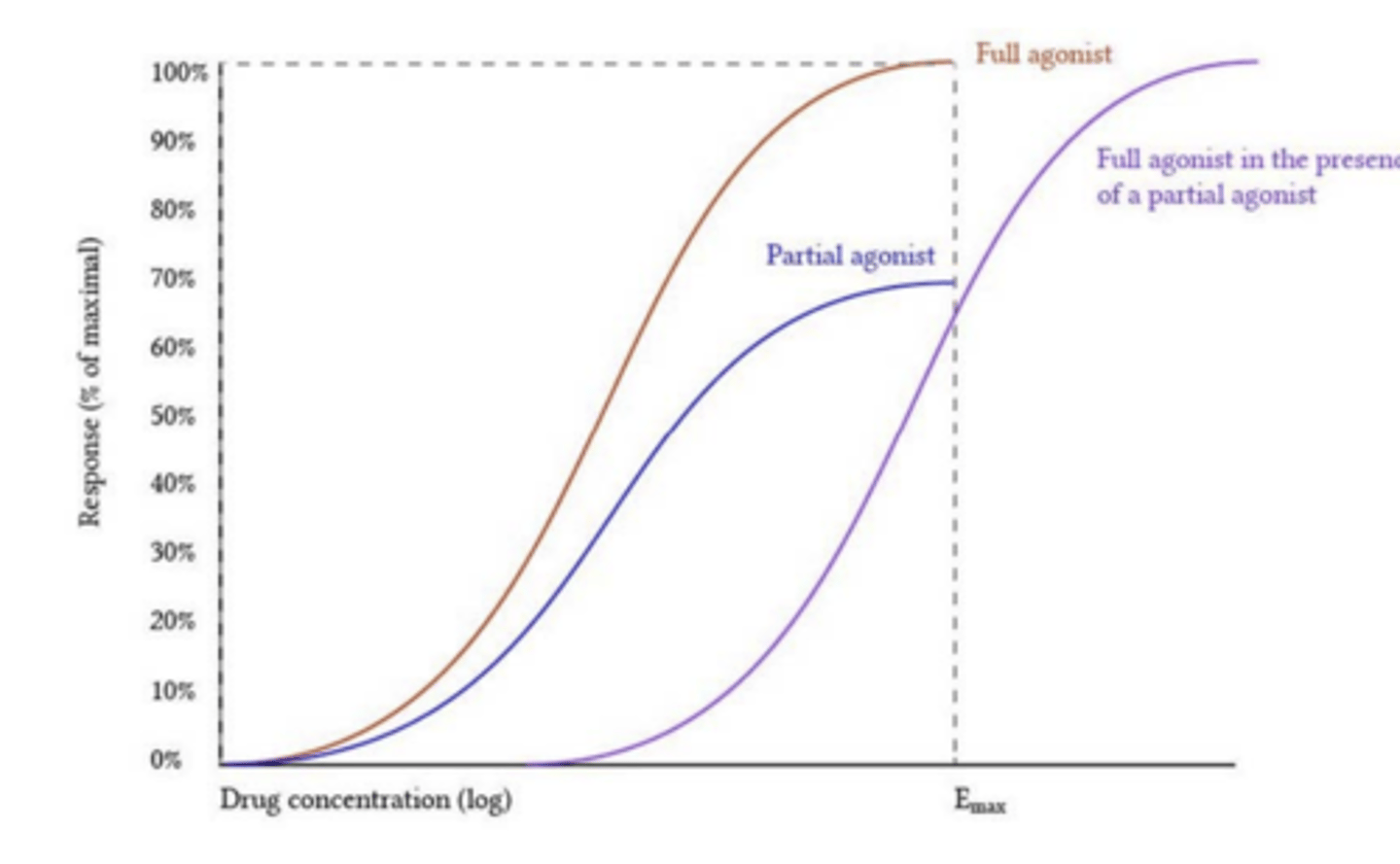
How can a maximal system response still be achieved?
the partial agonist can be displaced from the receptor by a sufficiently high concentration of full agonist
(unless partial agonist binds irreversibly)

In the presence of both a full and partial agonist, the efficacy of the full agonist is __________________, but its potency is ______________
- not affected
- reduced
(in graph, still reaches max response, but Ec50 is shifted to the right)
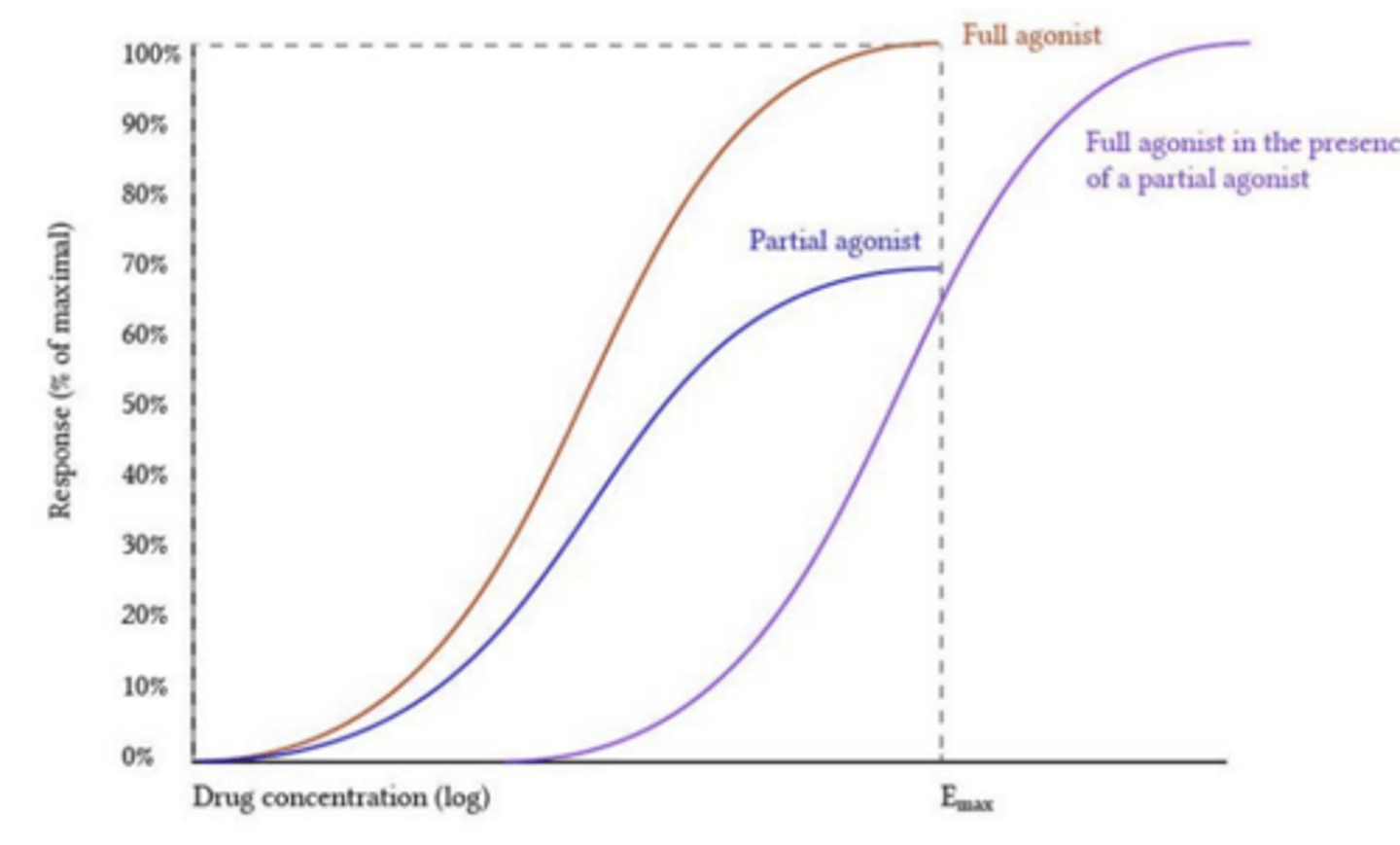
(Look at graph) Which drugs are more potent?
Drug A is more potent than drug C, drug B is more potent than drug C
- no comparisons of potency can be made between drugs A and B because one is a partial agonist, the other is a full agonist
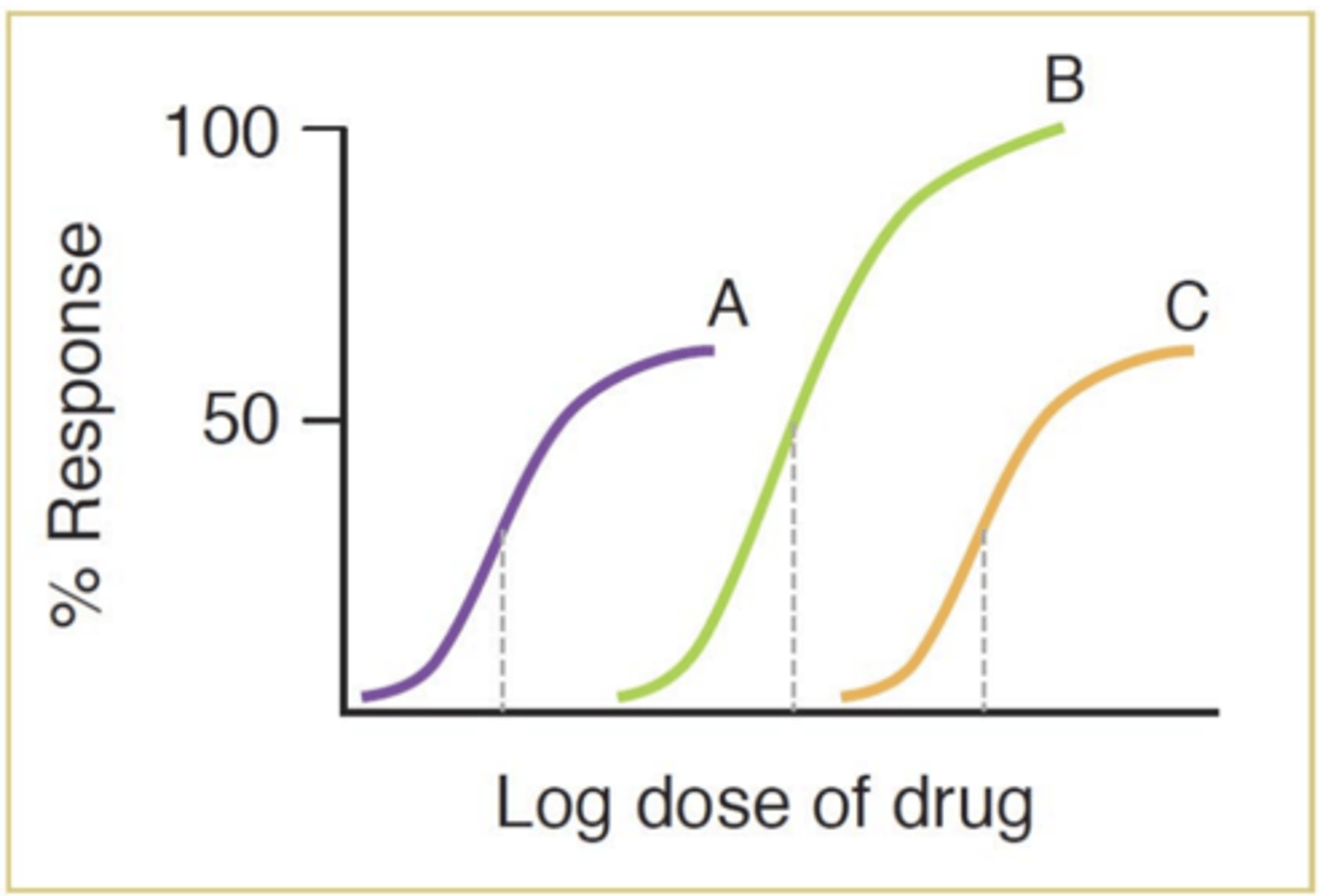
At low responses, are partial agonists or full agonists more potent? At high responses?
- at low responses, partial agonists are more potent
- at high responses, full agonists are more potent
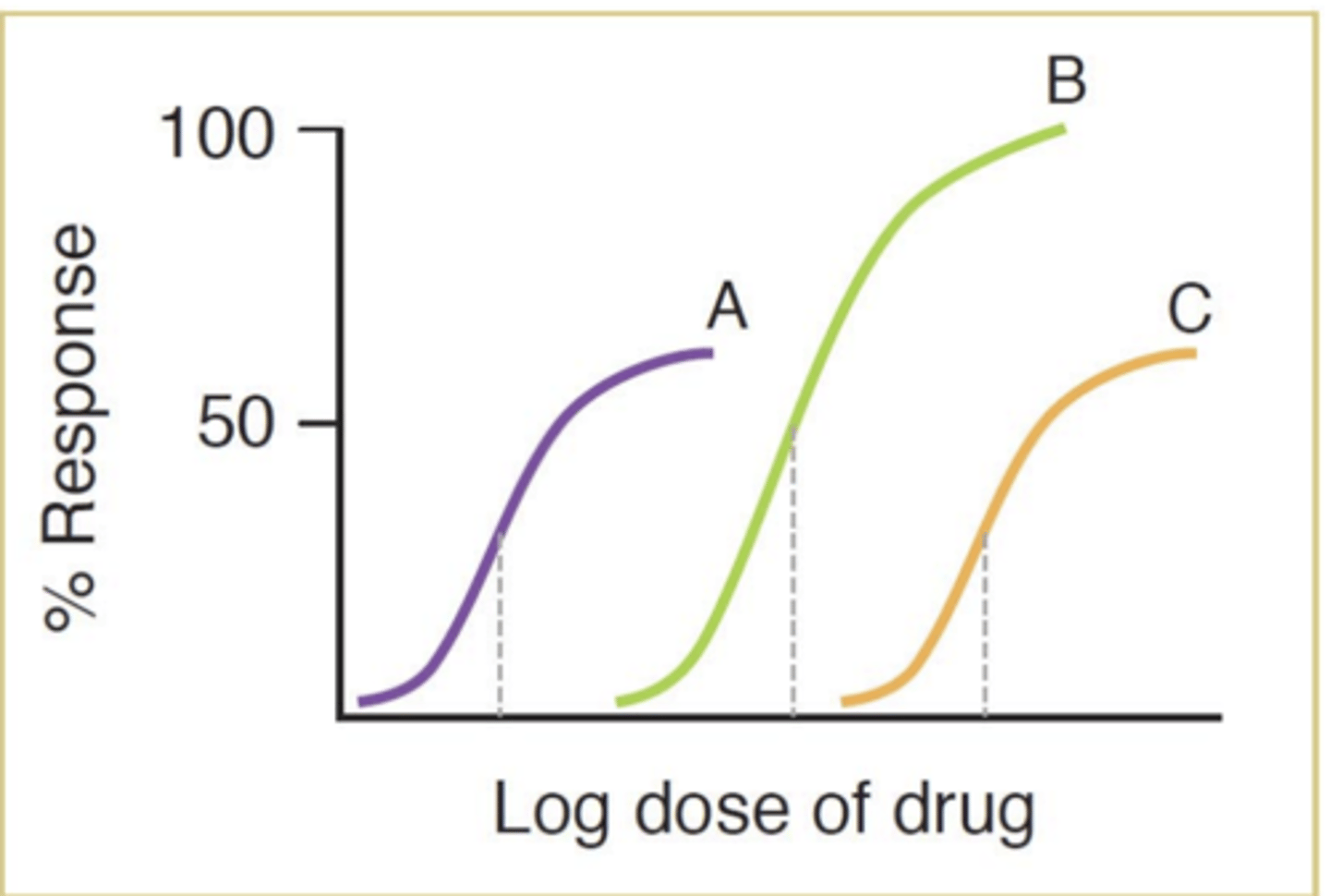
In low concentrations, ____________________ are more potent
partial agonists

T/F: Affinity of a full agonist is always higher than that of a partial agonist
FALSE
affinity of a partial agonist can be higher
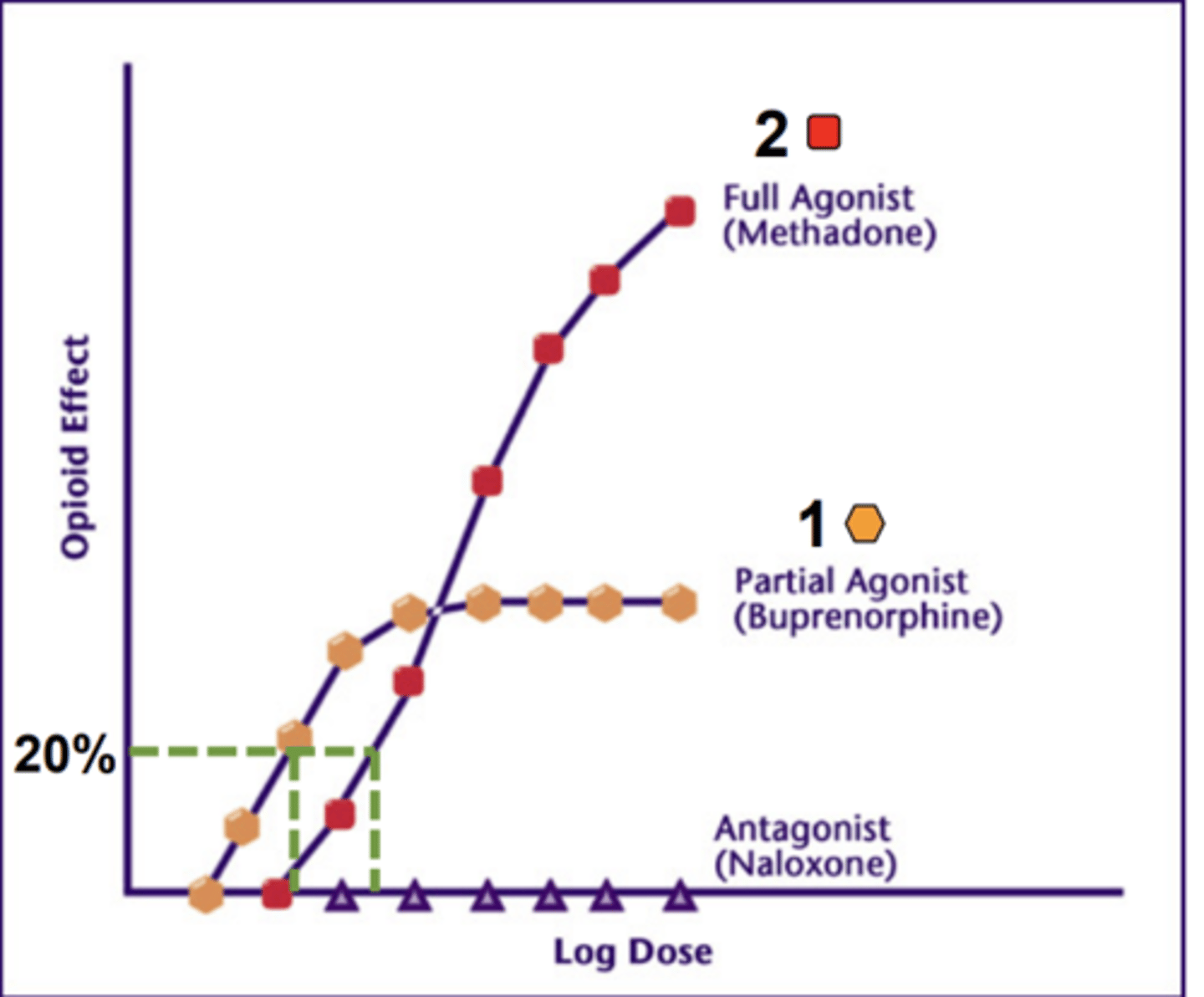
At low concentrations, is the partial agonist more potent than the full agonist?
YES
(in graph, the dose of the partial agonist needed to achieve 20% of max response is lower than that of the full agonist)
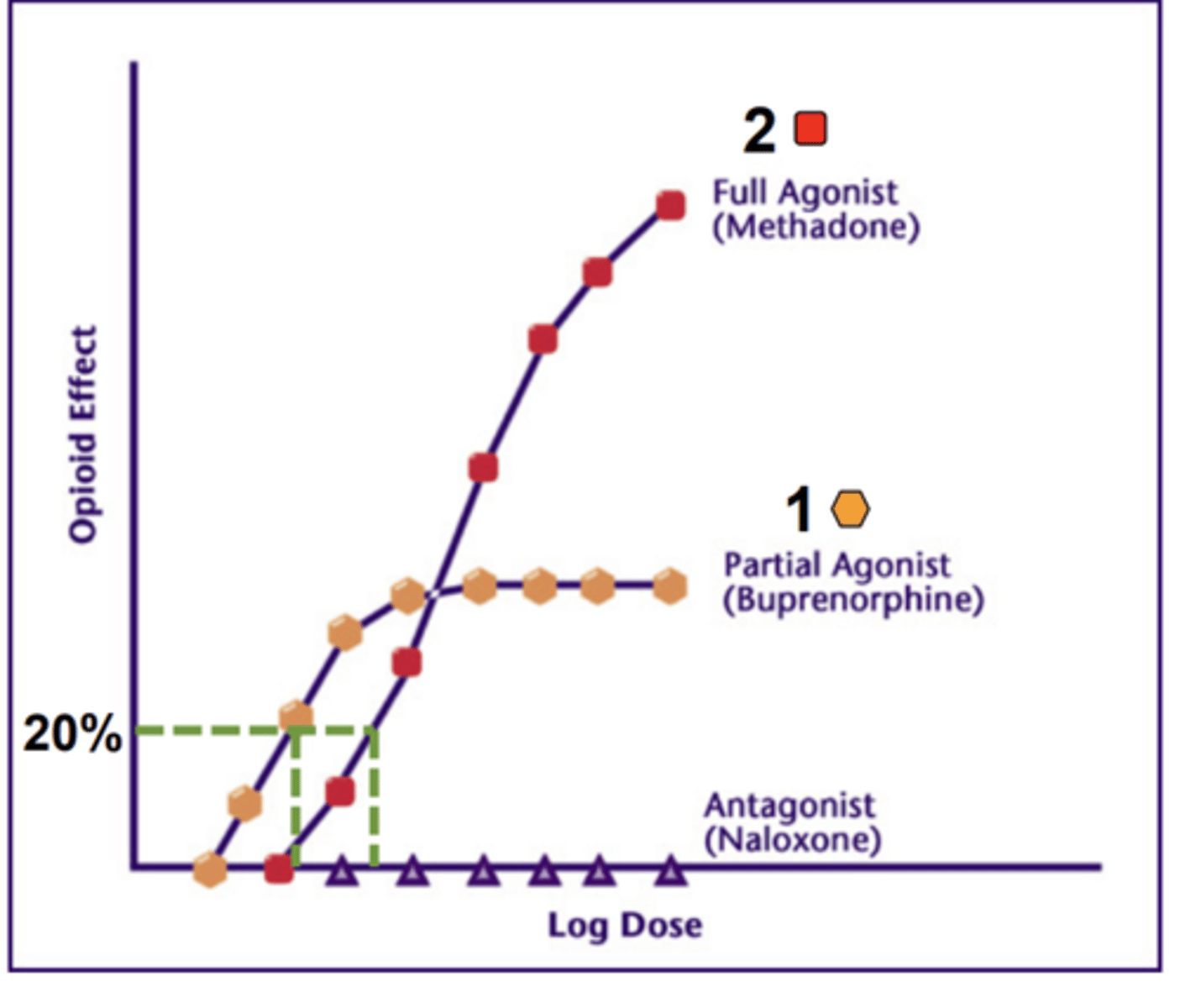
T/F: No matter how high the dose of a partial agonist is, it can never reach max response
TRUE
- even if a partial agonist occupies 100% of receptors, it cannot produce the max. response (ceiling effect)
(in the ex., only produces 10% of the max response regardless of the dose used)
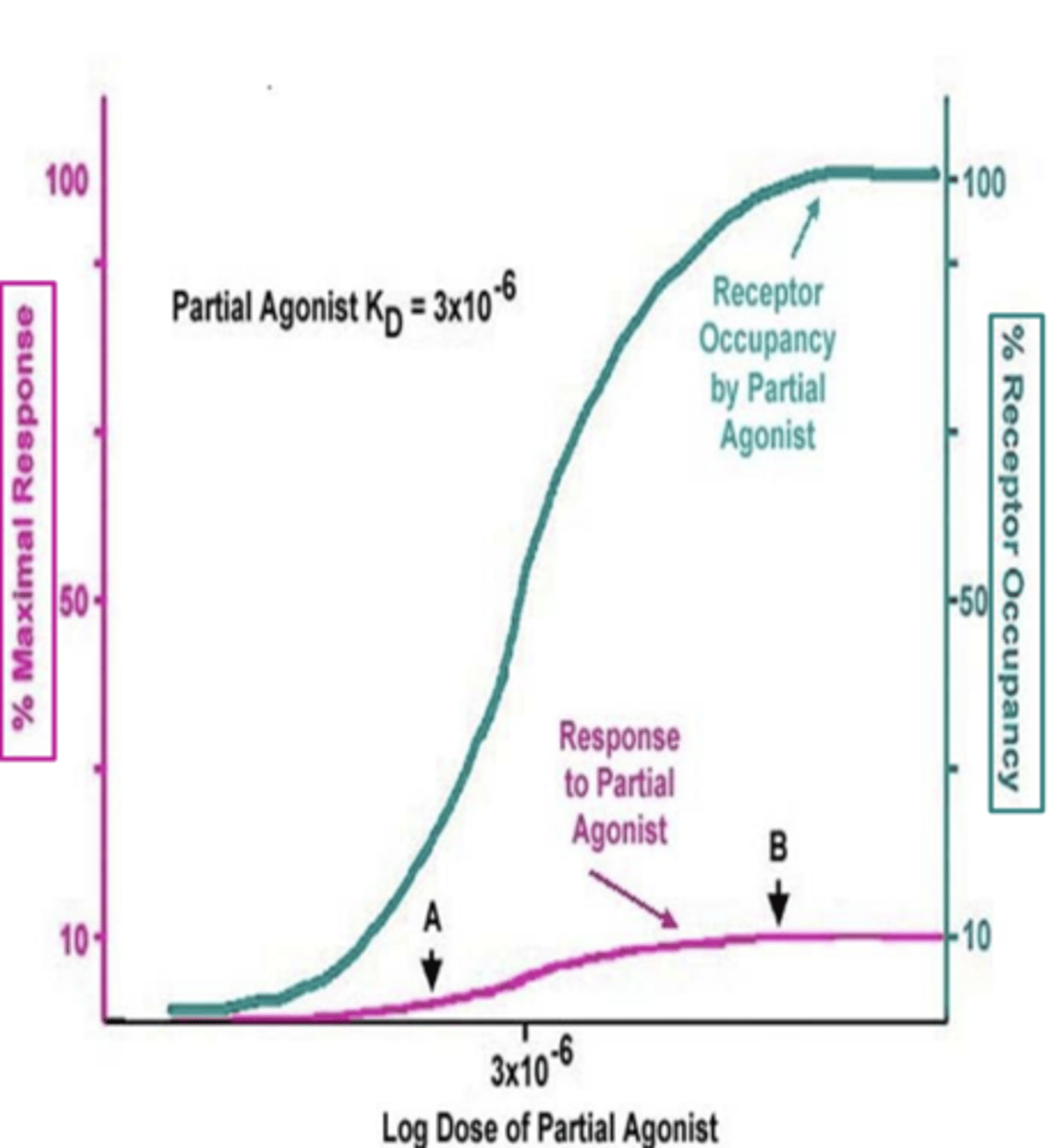
What does increasing the concentration of a partial agonist do to the full agonist?
inhibits the binding of a full agonist
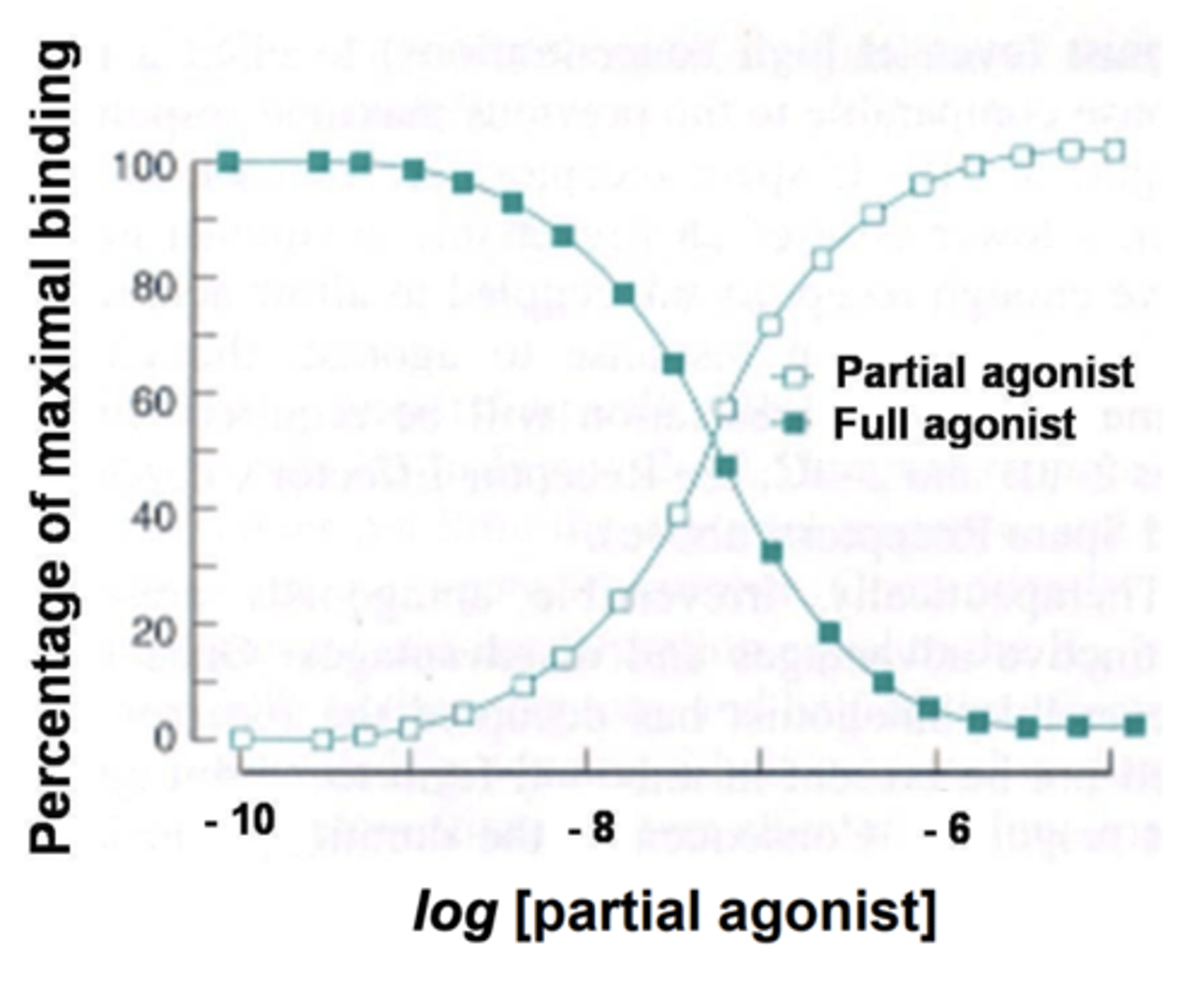
the partial agonist competes with the full agonist for binding sites and gradually.......
displaces the full agonist from the receptor

Once enough of the partial agonist is added it completely....
displaces the full agonist from receptor binding sites

As the partial agonist displaces the full agonist from the receptor, the response is reduced-the partial agonist is acting as an....
antagonist
(upper curve on graph shows effect of increasing doses of the partial agonist on the maximal response (100% achieved) in the presence of or by pretreatment of full agonist)
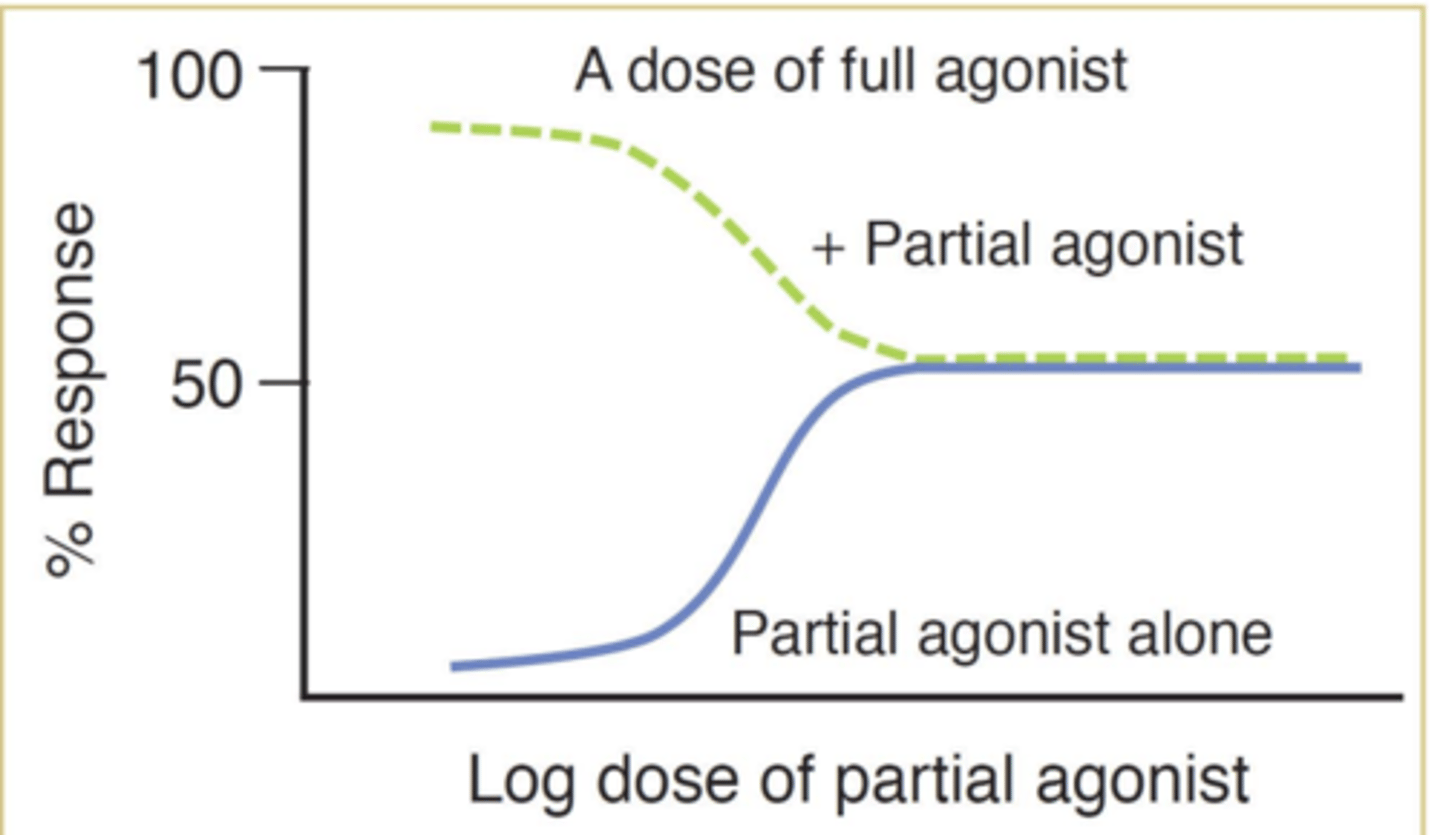
Increasing concentrations of a partial agonist......******
decreases the response of full agonist
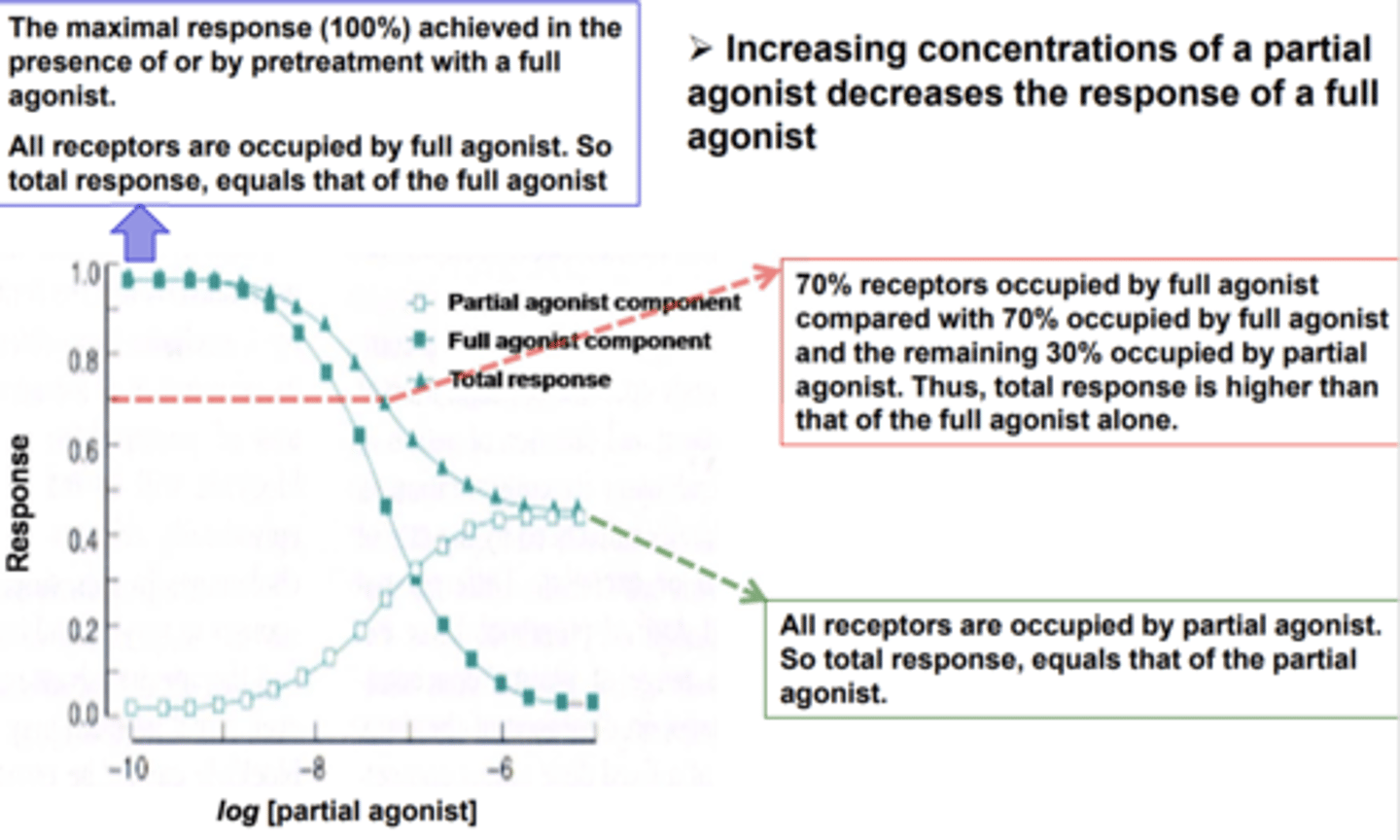
A single receptor can activate multiple ________________________________ that have ___________ or even ______________________ effects on cell function
- signaling pathways
- distinct or even opposite effects
Biased agonists*****
stabilize receptor conformation preferentially stimulating one of the pathways, allowing for more targeted modulation of cell function/disease treatment
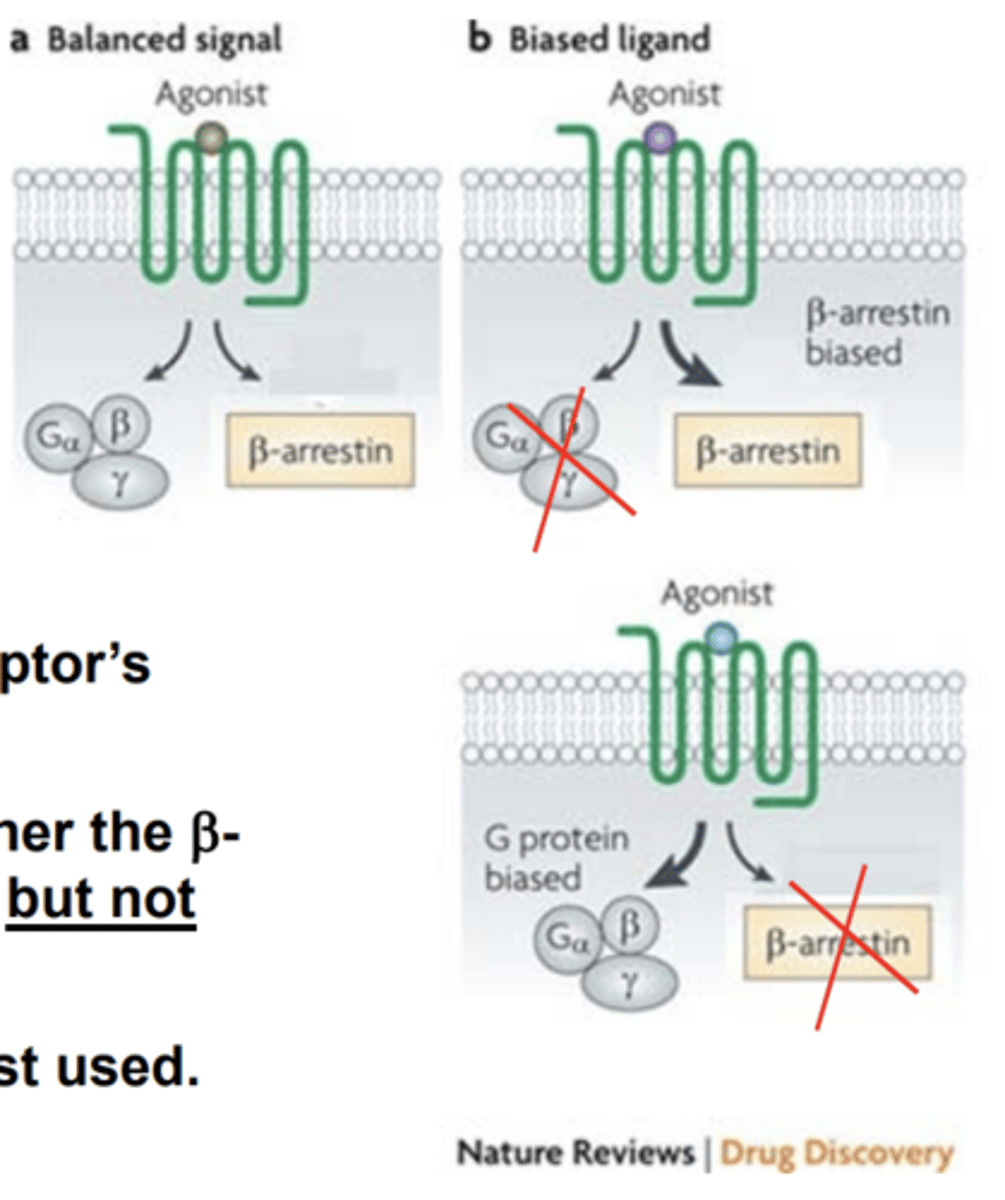
Biased agonism is most extensively characterized at what?
G protein coupled receptors (GPCRs)
- the degree each pathway is activated to depends on which ligand binds

Biased agonism: For GPCRs, the subset is either the ________________ mediated signaling events or the _____________ but NOT ___________________________
- β-arrestin
- Gα events
- both pathways simultaneously

Inverse agonist
ligand that binds to a receptor, producing the opposite effect that would be produced when an agonist binds the same receptor

inverse agonists _________ the intrinsic activity of the free (unoccupied) receptor
abrogate (gets rid of)
Inverse agonists are linked/tied to a certain pool of receptors that exhibit measurable level of ________________________ in the absence of ________________
- constitutive activity (activation of downstream signaling)
- agonist stimulation
(evidenced by the detection of second messengers in the absence of agonist stimulation. NOT ALL RECEPTORS ARE CONSTITUTIVELY ACTIVE)

Inverse agonist will not have any effect in a _______________, since there is no activity to ____________ the absence of agonist
- pure induction model
- inhibit
Only if there is a certain _______________________, will an inverse agonist have an effect
"baseline" level of activity
Agents that bind to the agonist binding sites, stabilizing the receptor in its inactive conformational state lead to....
receptor inactivation, lowering the receptors "basal activity"
Inverse agonism: the 2 conformational states of receptor
- Active (Ra)
- Inactive (Ri)
An agonist binds with higher affinity to ________ than ________ = response
(Ra) than (Ri)
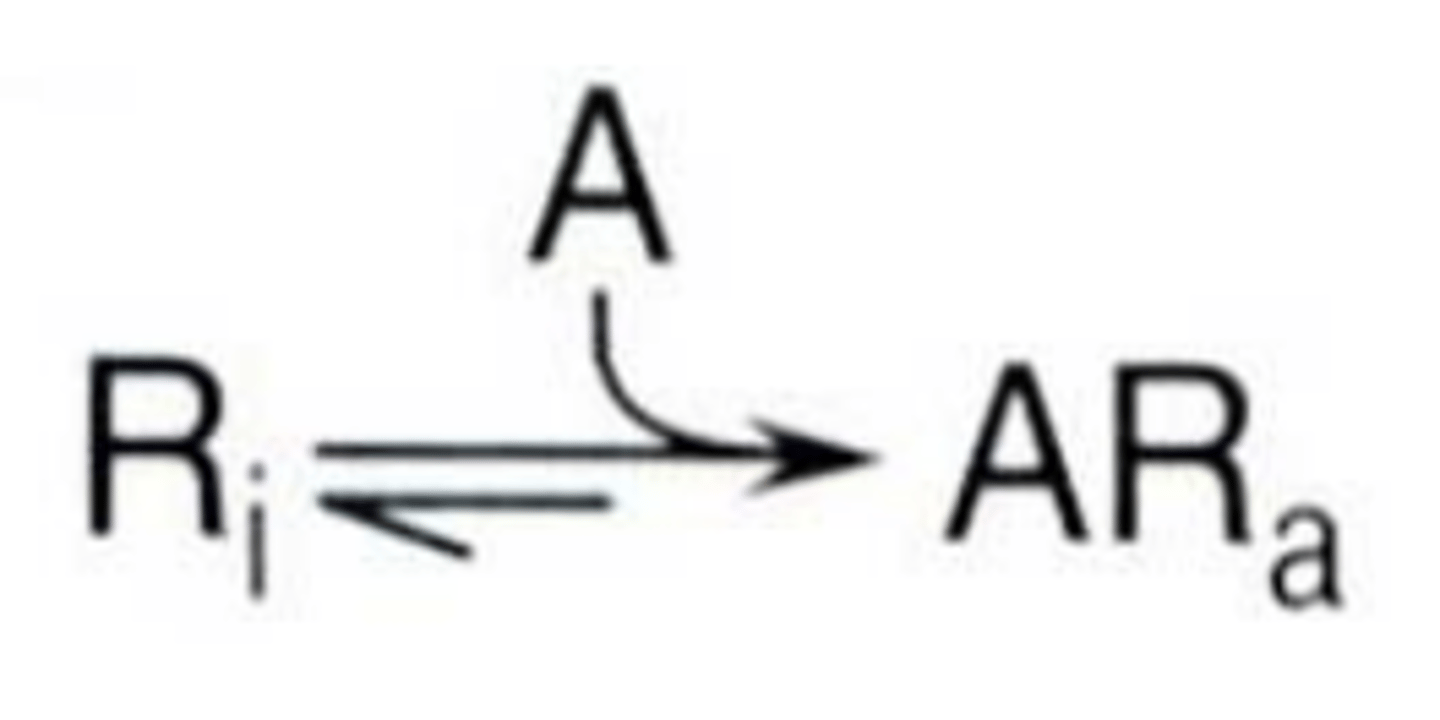
An inverse agonist binds with higher affinity to _________ than ________ and will shift _______________ in other direction
(Ri) than (Ra)
- equilibrium
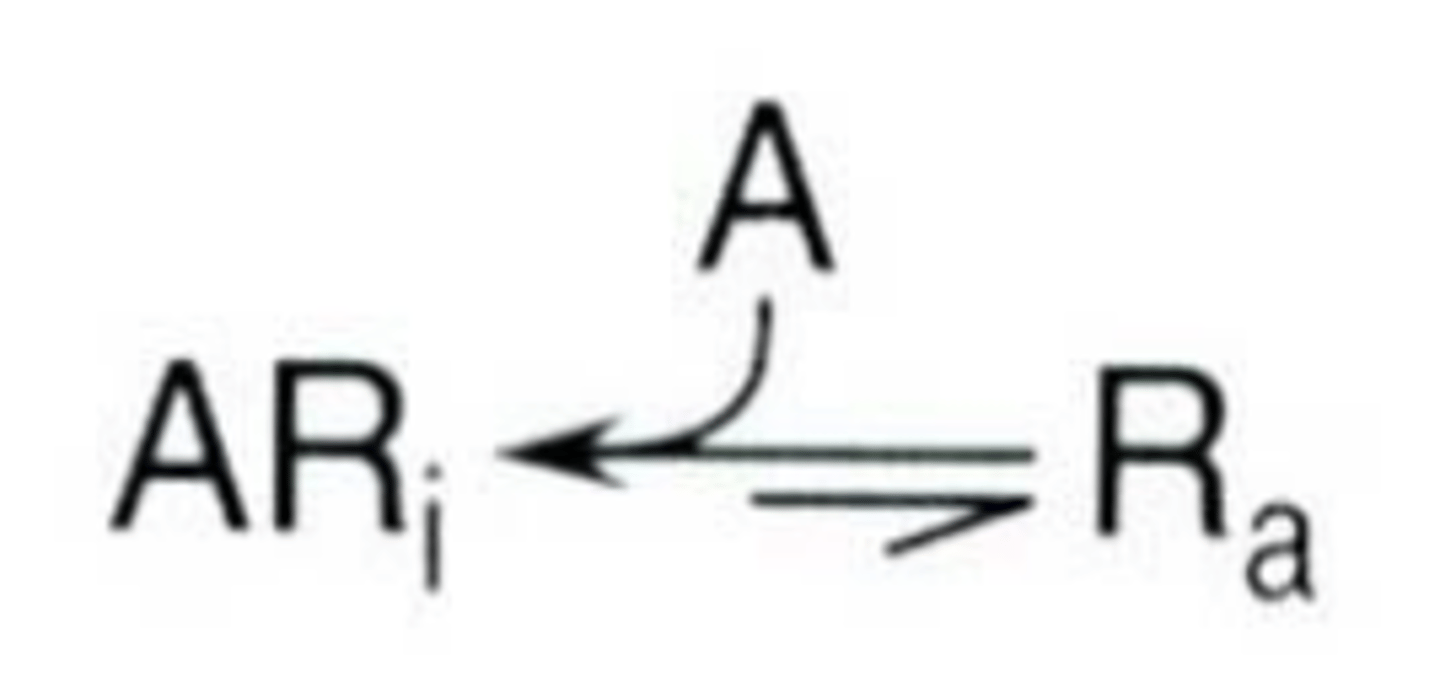
Both inverse agonists and agonists can be blocked by....
antagonists
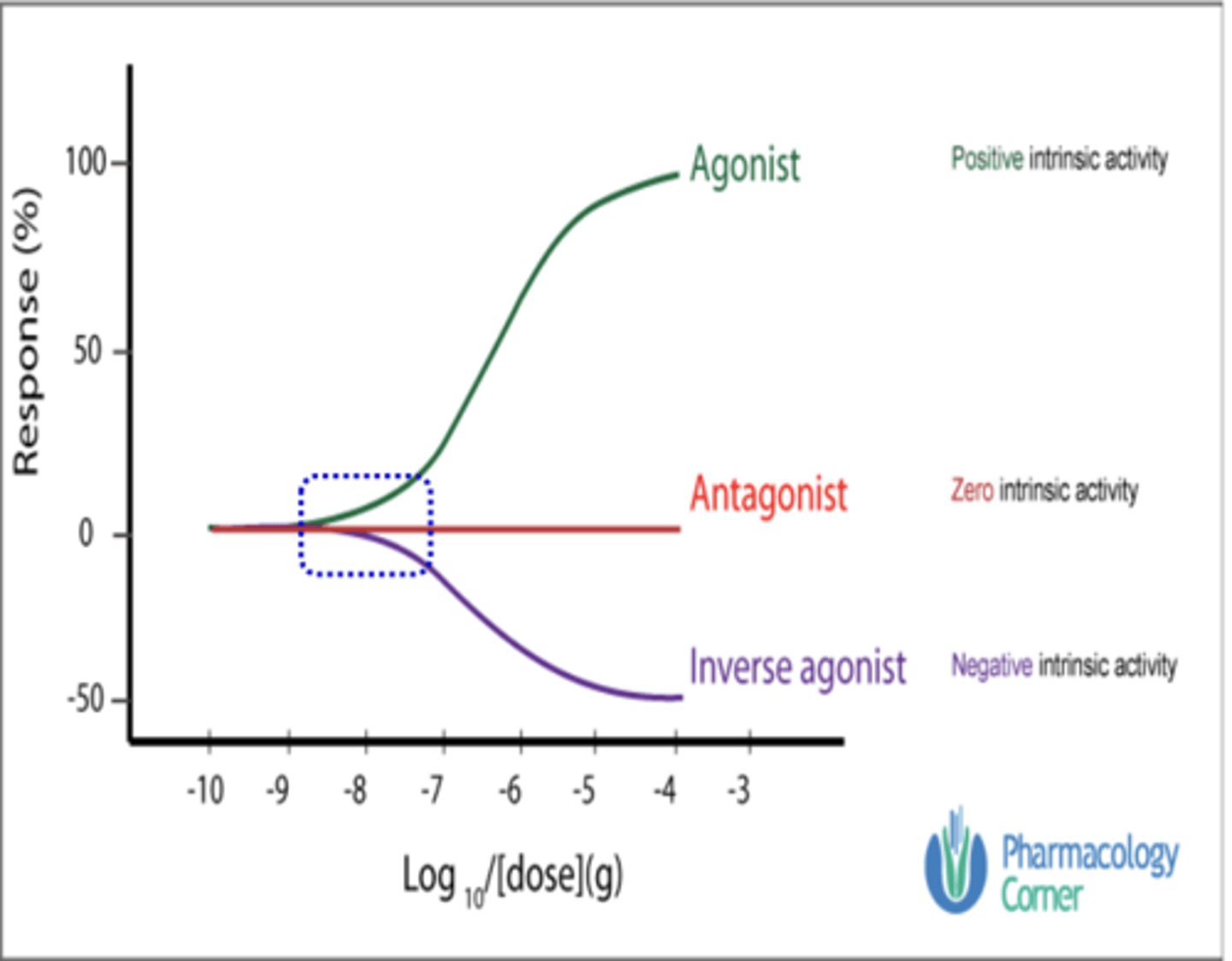
Neutral antagonist
has no activity in the absence of an agonist or inverse agonist, but can block the activity of either
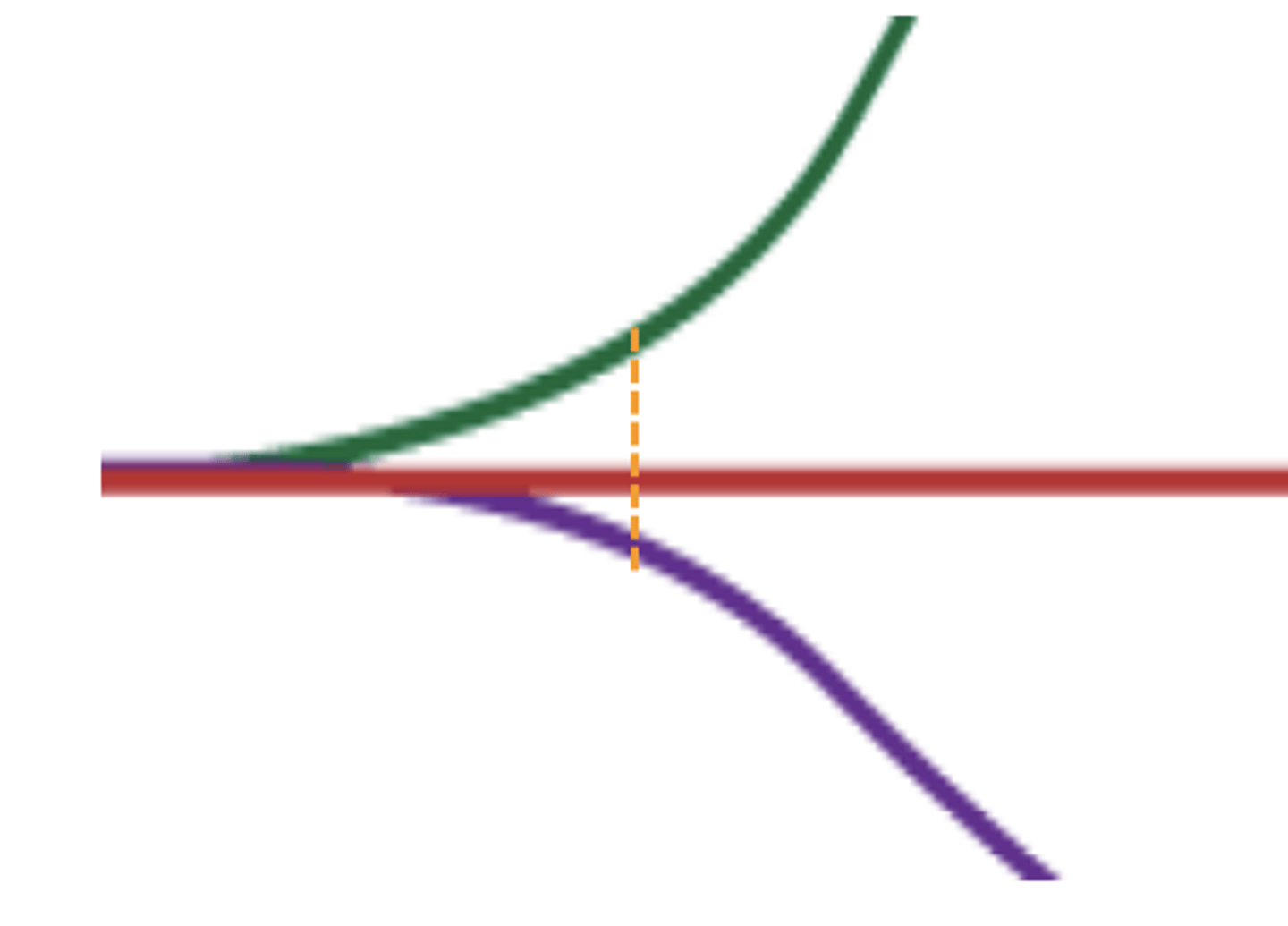
....
....
Two major types of antagonists
- competitive antagonist
- noncompetitive antagonist
What is a competitive antagonist?
Does is show pharmacological effect?
What is its inhibition mediated by?
antagonists that bind to the same binding sites as agonists, inhibiting its binding/effect
Shows no pharmacological effect on the receptor by itself (lacks intrinsic activity)
mediated by a steric mechanism
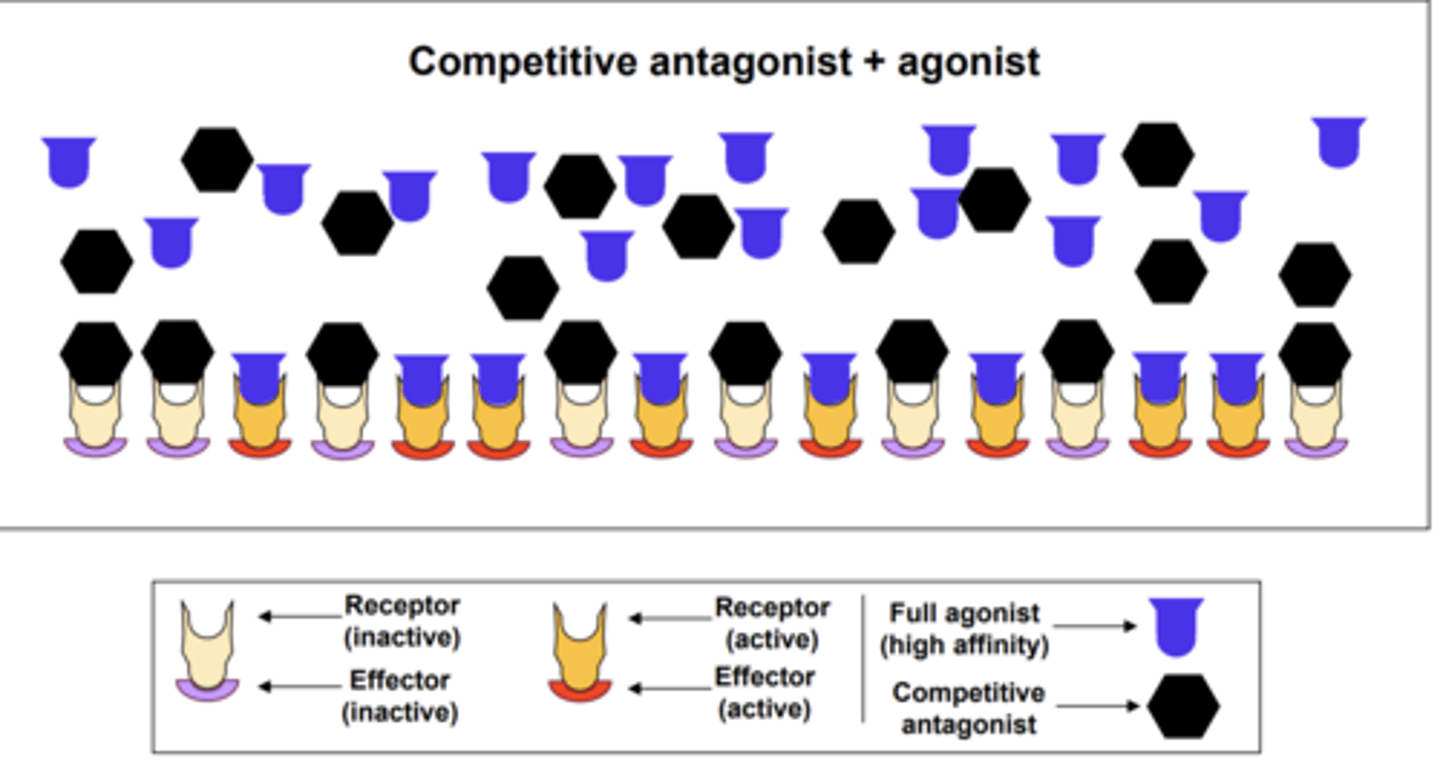
How can the effect of a competitive antagonist be reversed (or surmounted?
by increasing the concentration of the agonist
(a competitive antagonist increases the agonist concentration required for a given response)
When the full agonist is present with a fixed concentration of competitive antagonist, the potency of the agonist is __________, but the maximum efficacy _______________
reduced, but the maximum efficacy is not
(similar effect as a partial agonist)
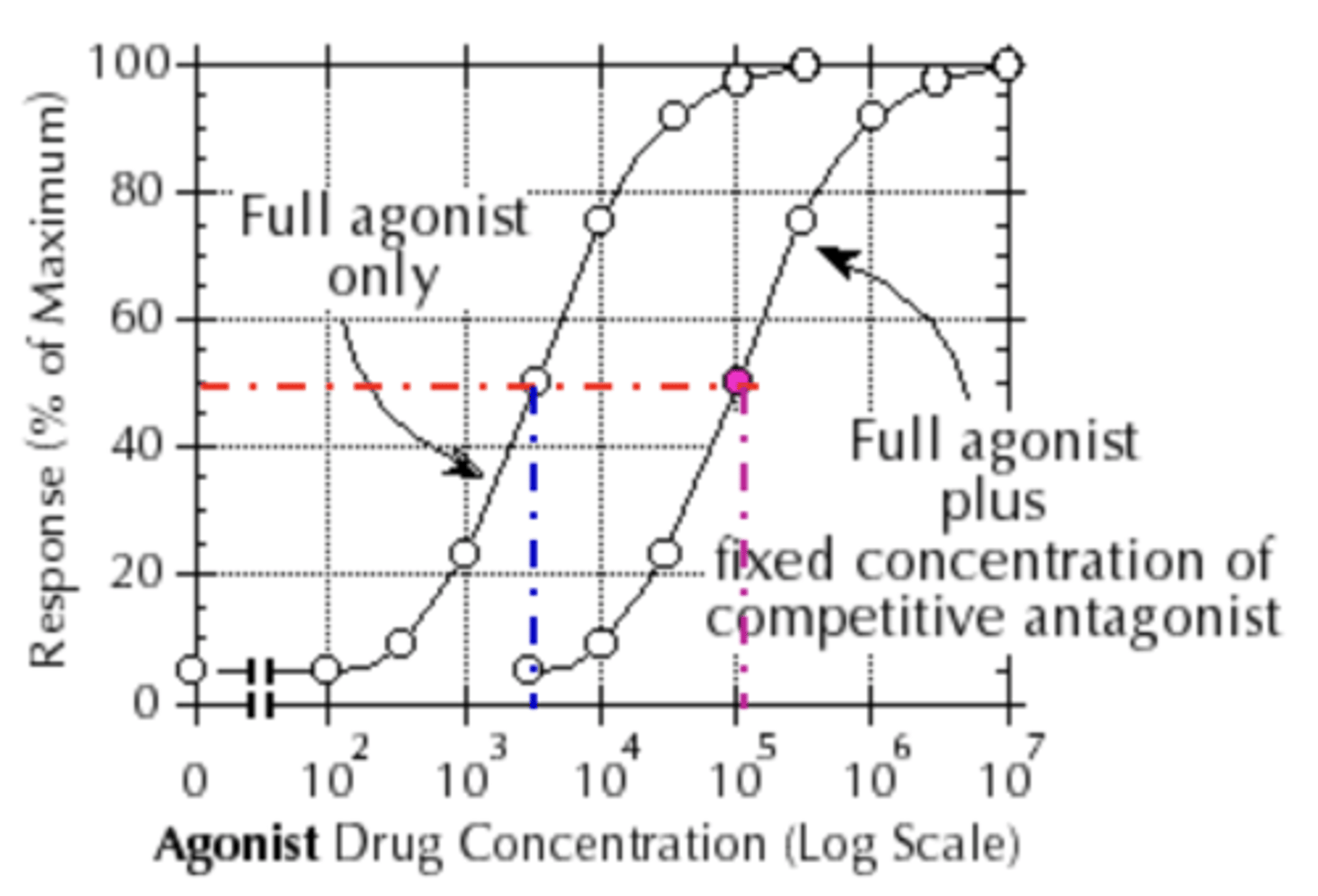
Knowing IC50, what can we calculate?
the Ki (inhibition constant)
When there is just one binding site, what does Ki equal?
Ki = Kd
When drug I (competitive antagonist) is present at increasing concentrations, it is necessary to apply ___________________ of drug A (agonist) to obtain the ______________________
- higher concentrations
- same maximal effect (shift to the right)
EC50 of drug A increases linearly with the concentration of drug I
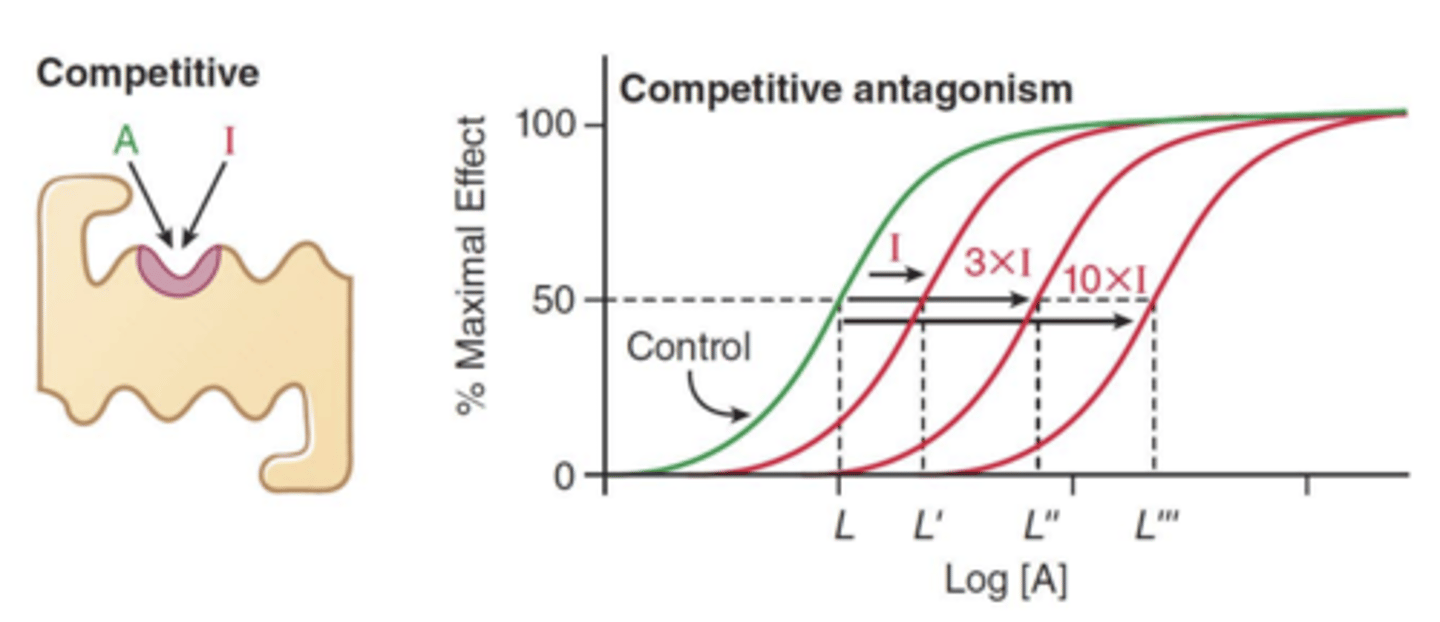
The EC50 of drug A increases ________________ with the concentration of drug I
linearly
Key features of a competitive antagonist:
- _______________ binding to the receptor
- blockade can be overcome by.......
- the maximal response of the agonist is not __________________
- reversible
- increasing the agonist concentration
- not decreased
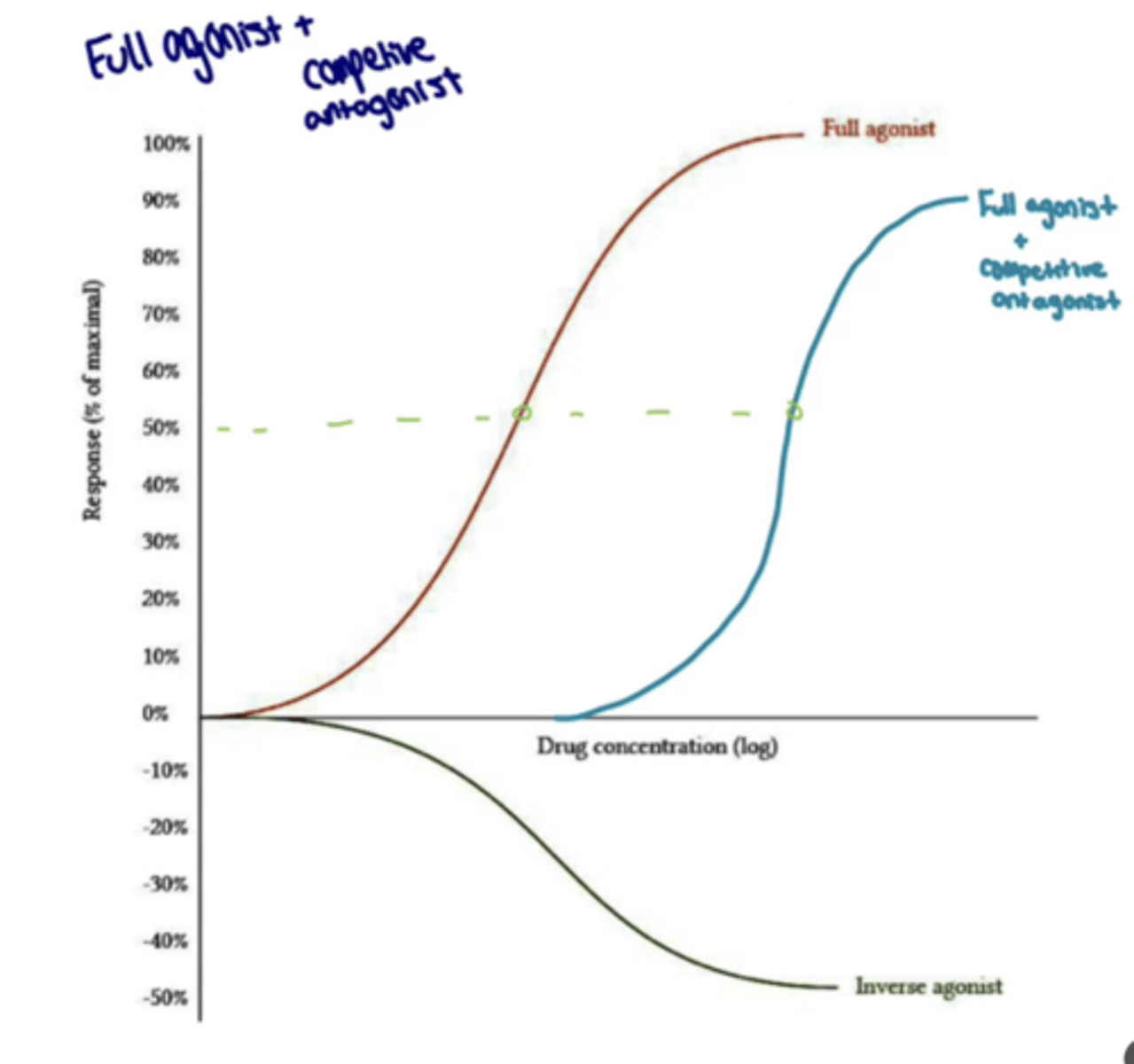
The agonist dose-response curve in the presence of a competitive antagonist is shifted parallel to the ________ with no
____________________________________
- right
- no change in the maximal response
(change in potency)
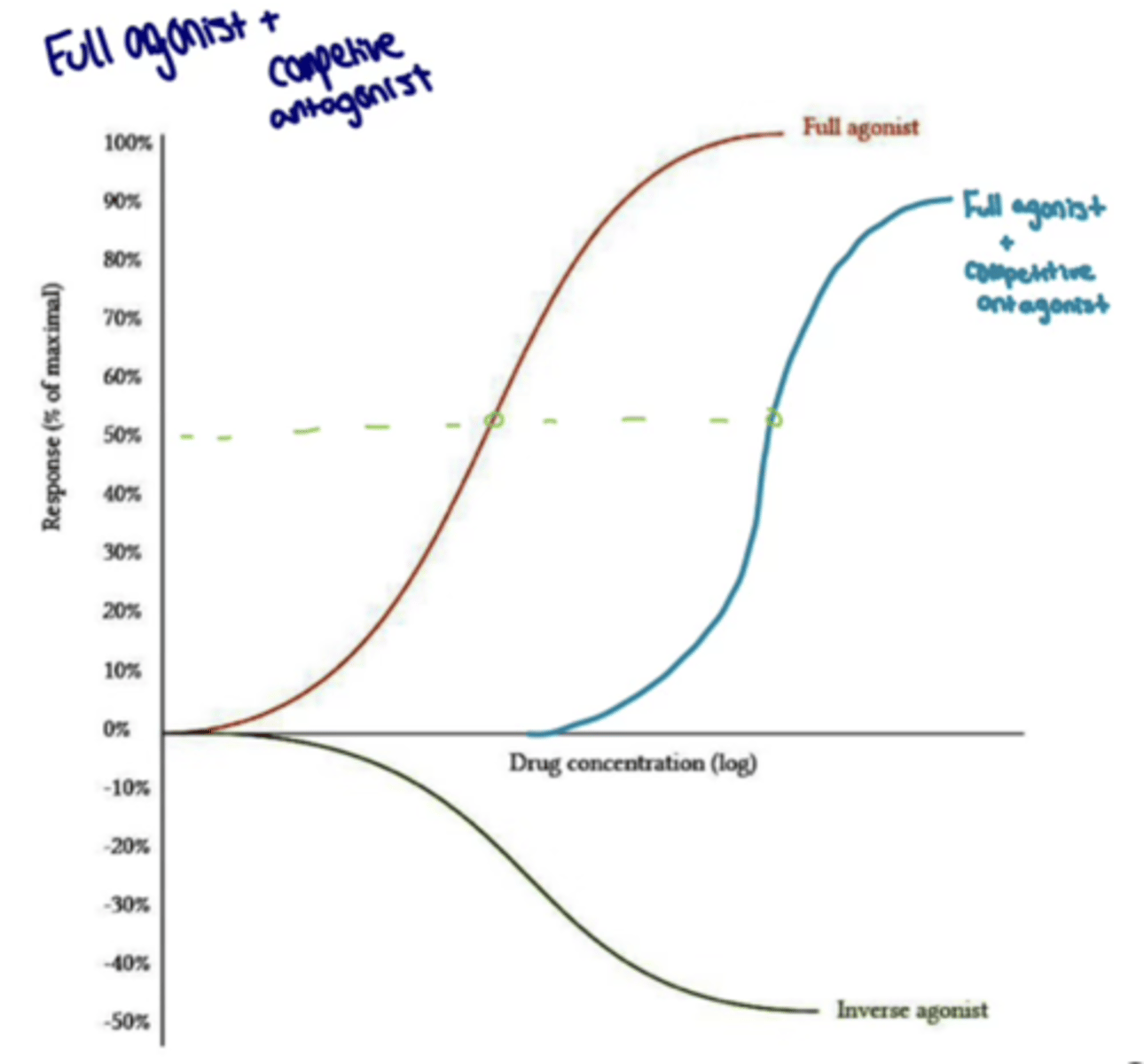
Noncompetitive antagonists (allosteric antagonists)
bind irreversibly to sites different from the agonist binding site(s) but inhibit the receptor function
- mediated by an allosteric mechanism*
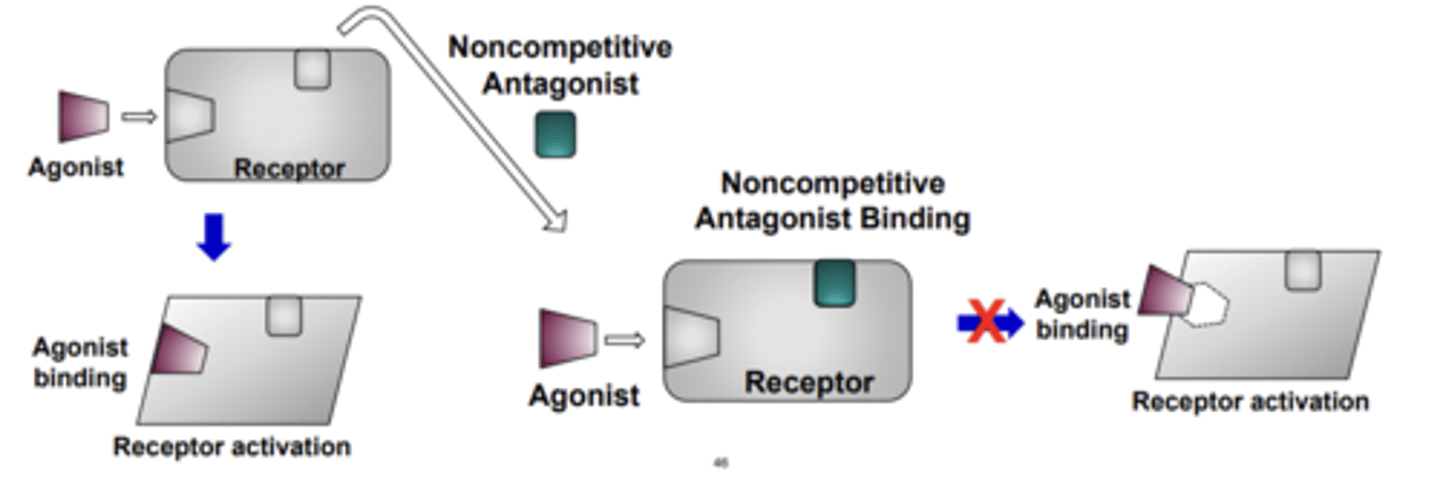
T/F: noncompetitive antagonists compete for the same binding site as agonists
FALSE
do NOT compete for same sites

The bound noncompetitive antagonist may prevent....
conformational changes in the receptor required for receptor activation
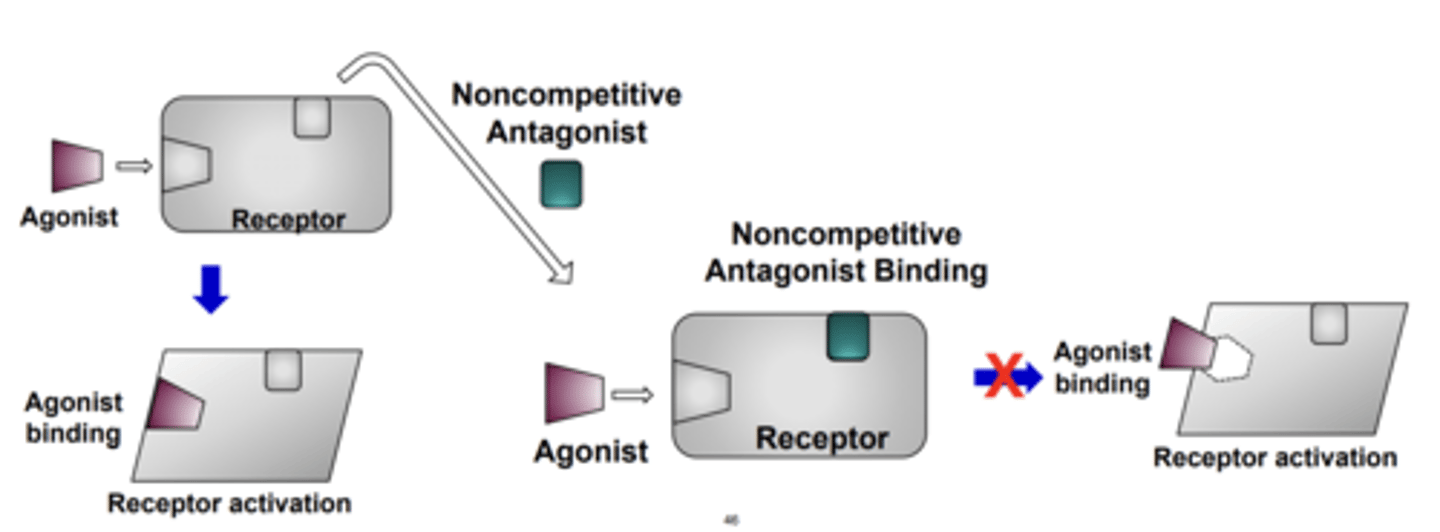
Do noncompetitive antagonists decrease an agonist's maximal effect?
YES
they decrease agonist maximal effect
- their effect is the same as removing receptors from the system
- reduce the # of receptors available to be activated

T/F: The actions of noncompetitive antagonists CAN be overcome by increasing the dose of agonist
FALSE
their actions CANNOT be overcome by increasing the dose

How do noncompetitive antagonists shift the sigmoidal curve of a full agonist?
shifts it downward and to the right
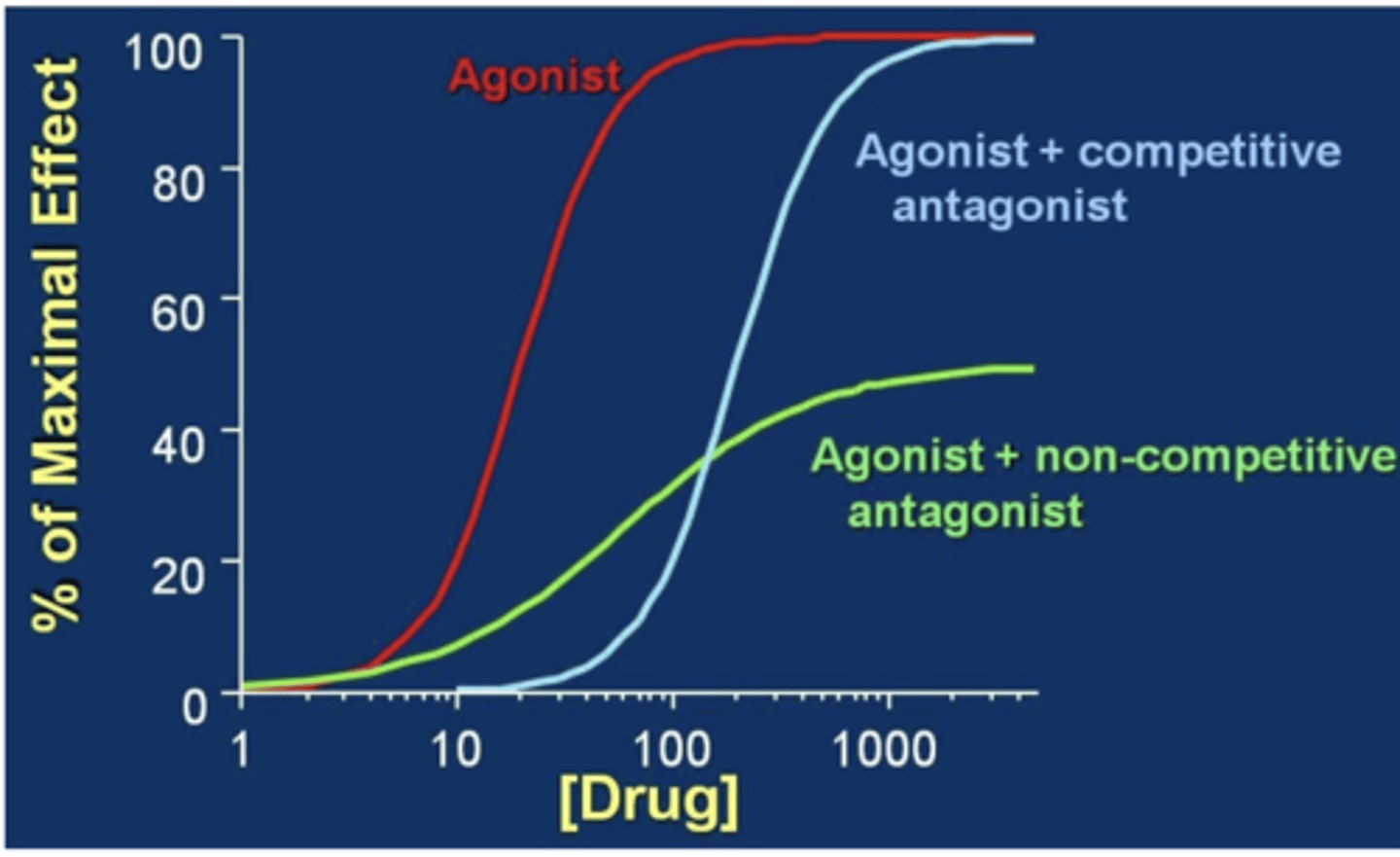
How do competitive antagonists shift the sigmoidal curve of a full agonist?
shifts to the right
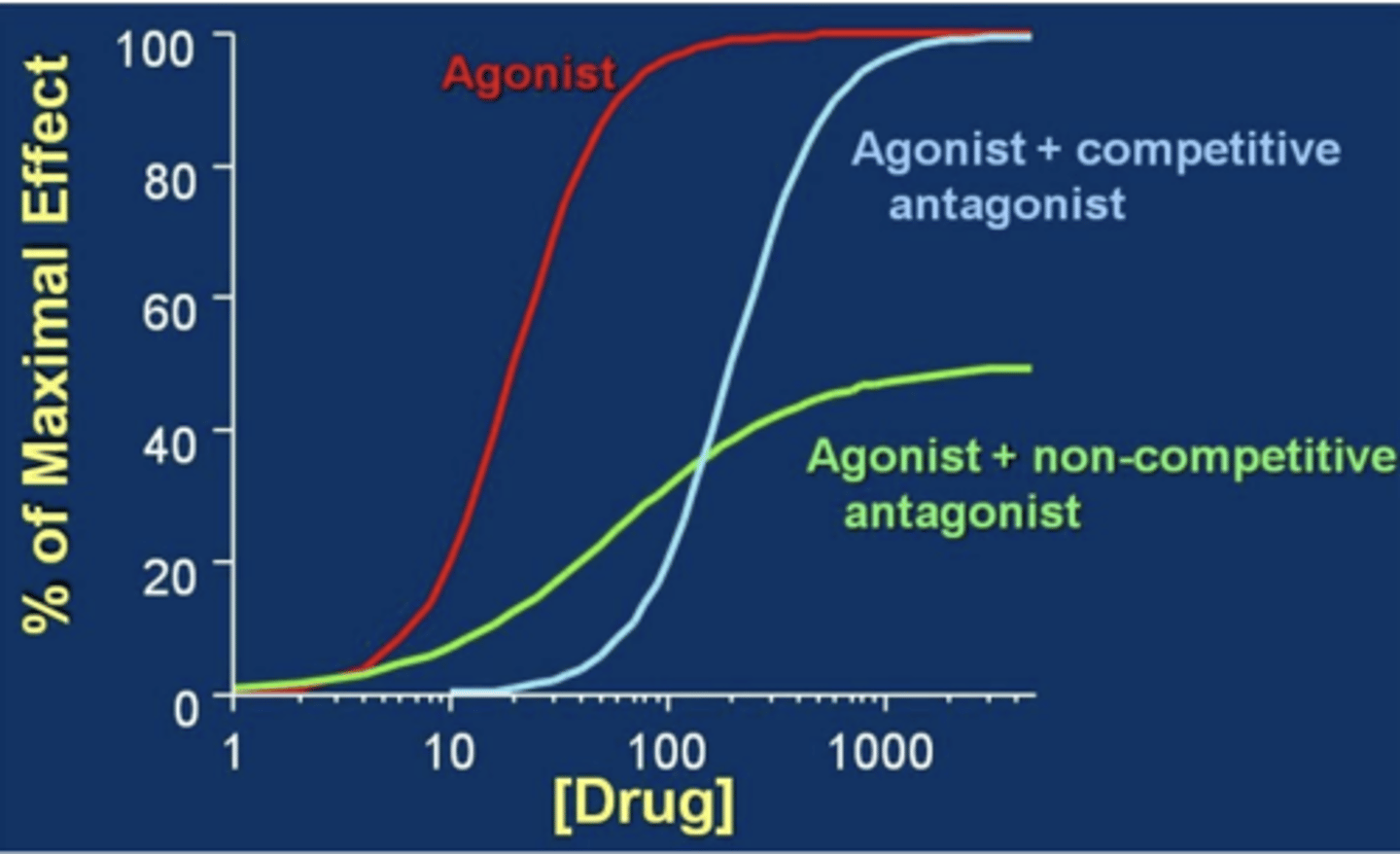
In the case of an allosteric antagonist, the affinity of the receptor for the agonist is....
decreased by the antagonist
(there is a decrease in the max. response, shifts right and downward)

What is a noncompetitive agonist? (aka co-agonist)
Drugs that bind to site(s) different from the agonist site(s) but enhance the agonist-activated receptor
- mediated by an allosteric mechanism* (conformation change that enhances effect)

In the presence of increasing concentrations of drug P (co-agonist), the maximal effect of drug A (agonist) is reached at lower concentrations (left-shifted or potentiation). What direction does the curve shift?
curve shifts upward and to the left

In the presence of a noncompetitive agonist, the full agonist's potency is __________________ and its efficacy is _______________________
- increased
- also increased
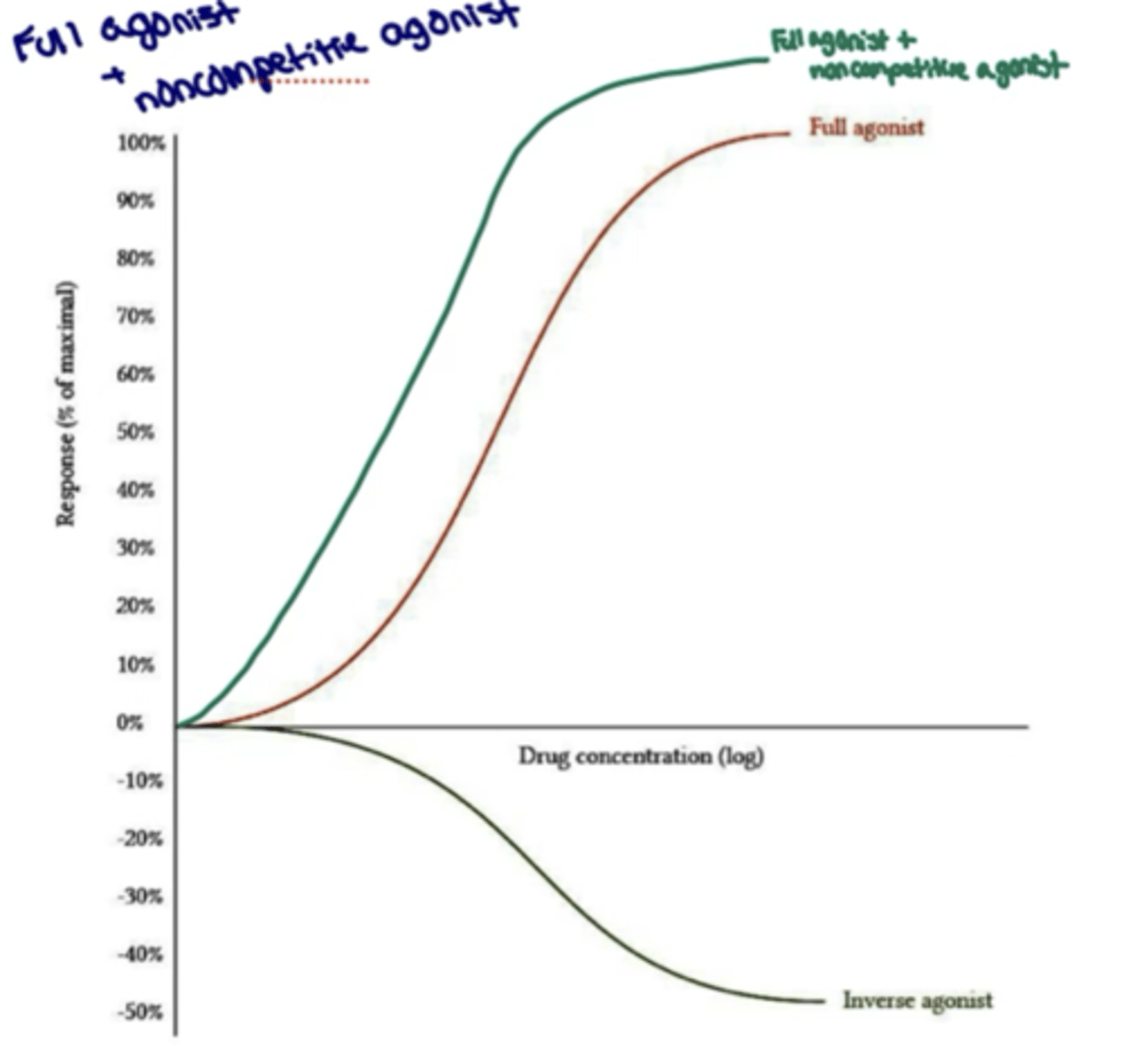
Irreversible antagonist
- chemically reactive compound, covalently binds with receptor
- receptor is irreversibly inactivated, blockade cannot be overcome with increasing agonist conc.
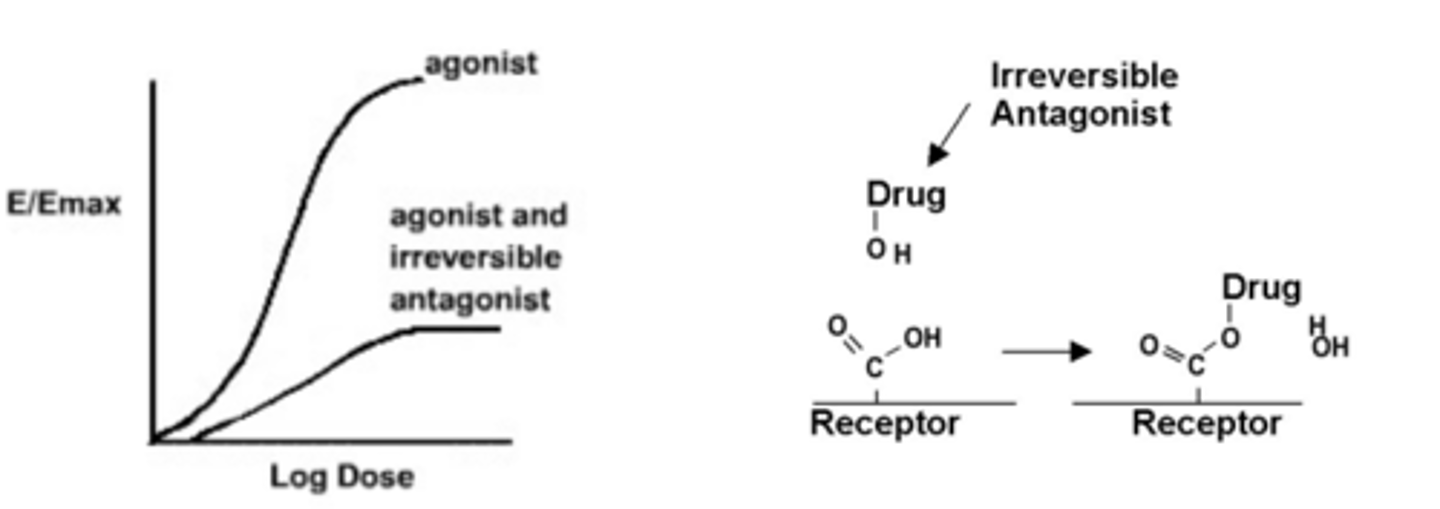
How does the curve shift in the presence of a irreversible agonist?
shifts the agonist dose-curve to the right and depresses maximal responsiveness
(same as noncompetitive)
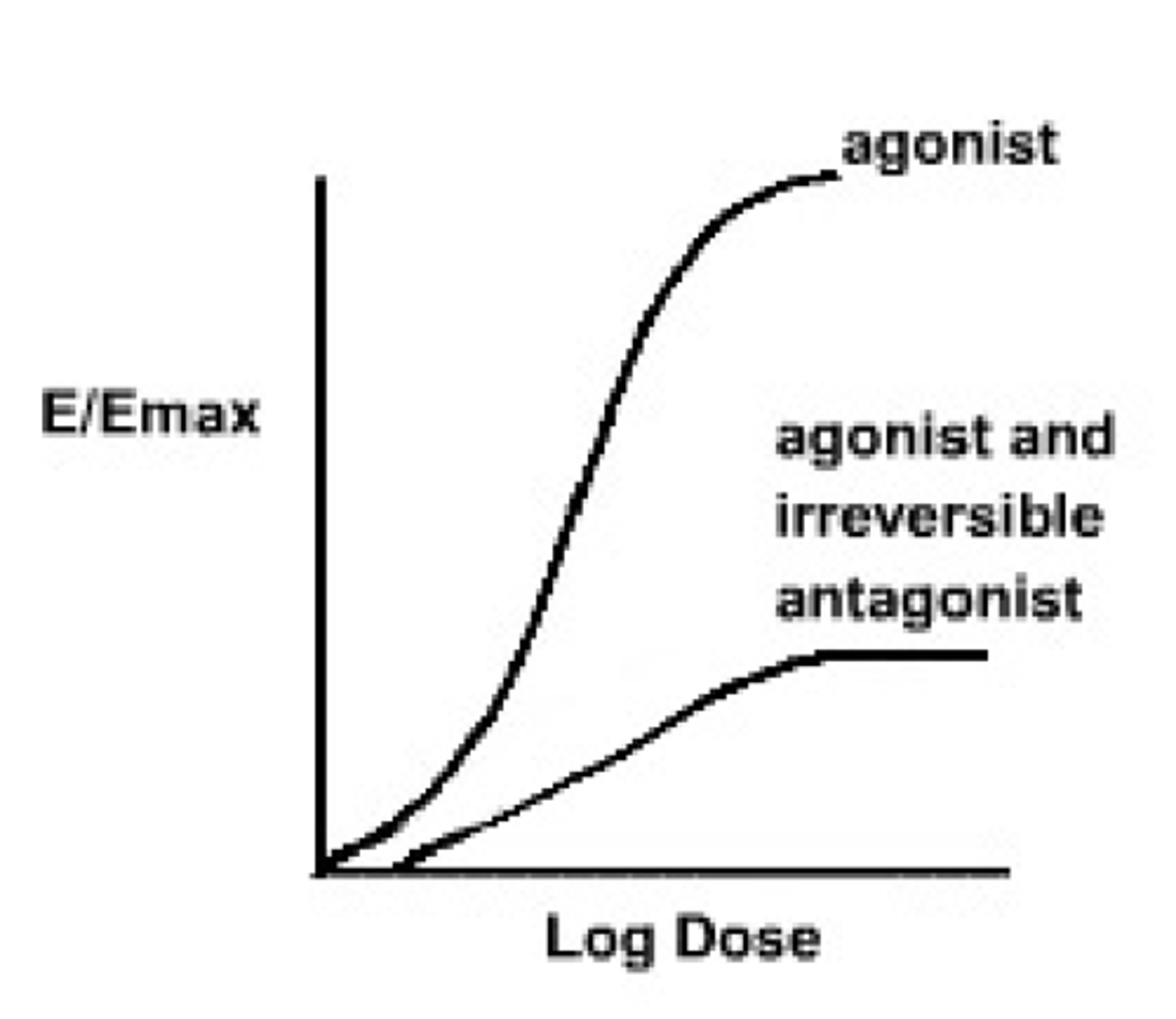
Chemical antagonist
- does not involve a receptor
- drug inactivates other drug by directly binding to the second drug (ex: chelator/sequester)
(heparin and protamine sulfate; portamine sul. inactivates heparin)